Lore:Statues/Aedra
Aedra[edit]
Contents
- 1 Aedra
- 1.1 Akatosh
- 1.2 Arkay
- 1.3 Auri-El
- 1.4 Dibella
- 1.5 Jephre
- 1.6 Jhunal
- 1.7 Julianos
- 1.8 Kyne
- 1.9 Kynareth
- 1.10 Magnus
- 1.11 Mara
- 1.12 Morwha
- 1.13 Orkey
- 1.14 Phynaster
- 1.15 Satakal
- 1.16 Shor
- 1.17 Stendarr
- 1.18 Stuhn
- 1.19 Syrabane
- 1.20 Tava
- 1.21 Tiber Septim / Talos
- 1.22 Trinimac
- 1.23 Tsun
- 1.24 Tu'whacca
- 1.25 Xarxes
- 1.26 Z'en
- 1.27 Zenithar
- 2 Notes
- 3 References
Akatosh[edit] | |||||||
 ESO ESO
|
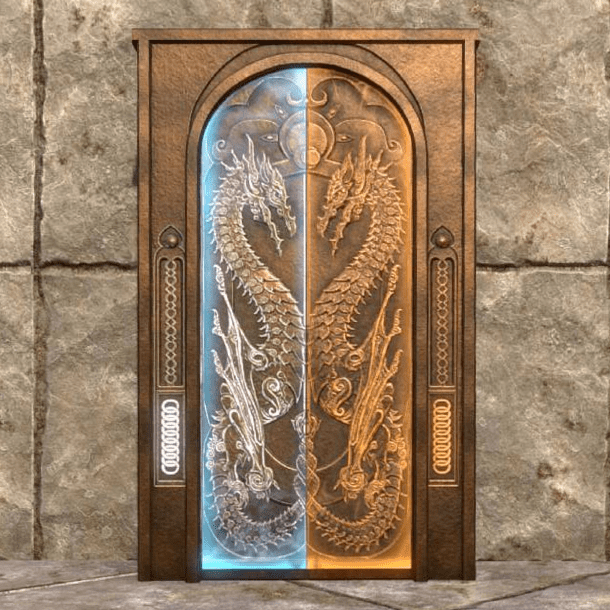 ESO ESO
|
 ESO ESO
|
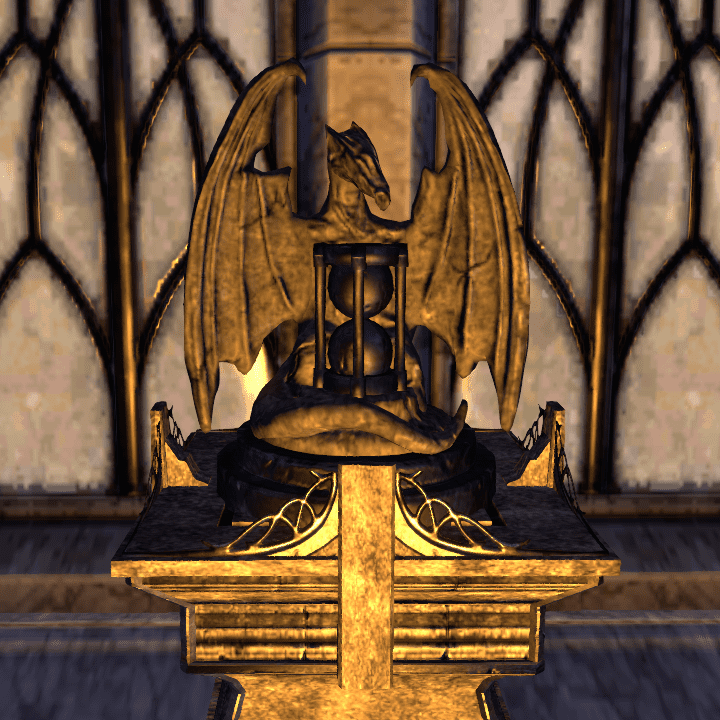 ESO ESO
|
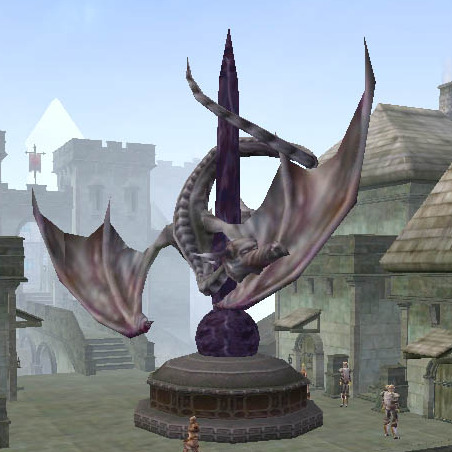 Morrowind Morrowind
| |||
|---|---|---|---|---|---|---|---|
| The ancient Khajiit in the early-First Era depicted Alkosh as a Dragon, much like the later Imperial depictions of Akatosh. Sunspire temple, built on the land where Alkosh drove Pelinal Whitestrake from Elsweyr, featured reliefs of Alkosh breathing fire and holding an hourglass, or alongside imagery of moons, which the Khajiit hold sacred.[1] Small and extremely detailed dragon statues dating further back were also used in his worship.[2] | Deep in the ruins of Knightsgrave a terrifying statue of Akatosh dominates a large ancient cave. Believed to date back to around the early-First Era, it was built by the Alessian Order, possibly to further their efforts in raising Akatosh above all other gods.[3] | During the mid-Second Era, once the worship of Akatosh and the Divines had become firmly established, small statuettes of the Dragon God could be found in temples and cathedrals across human lands, alongside grander depictions such as in stained glass cathedral windows.[4] | By the late-Third Era Morrowind had come under the rule of the Empire, who often used Dragon-related imagery in its heraldry.[5] A vast statue of Akatosh stood in Dragon Square in the Dunmer city of Ebonheart during this time.[6] | ||||
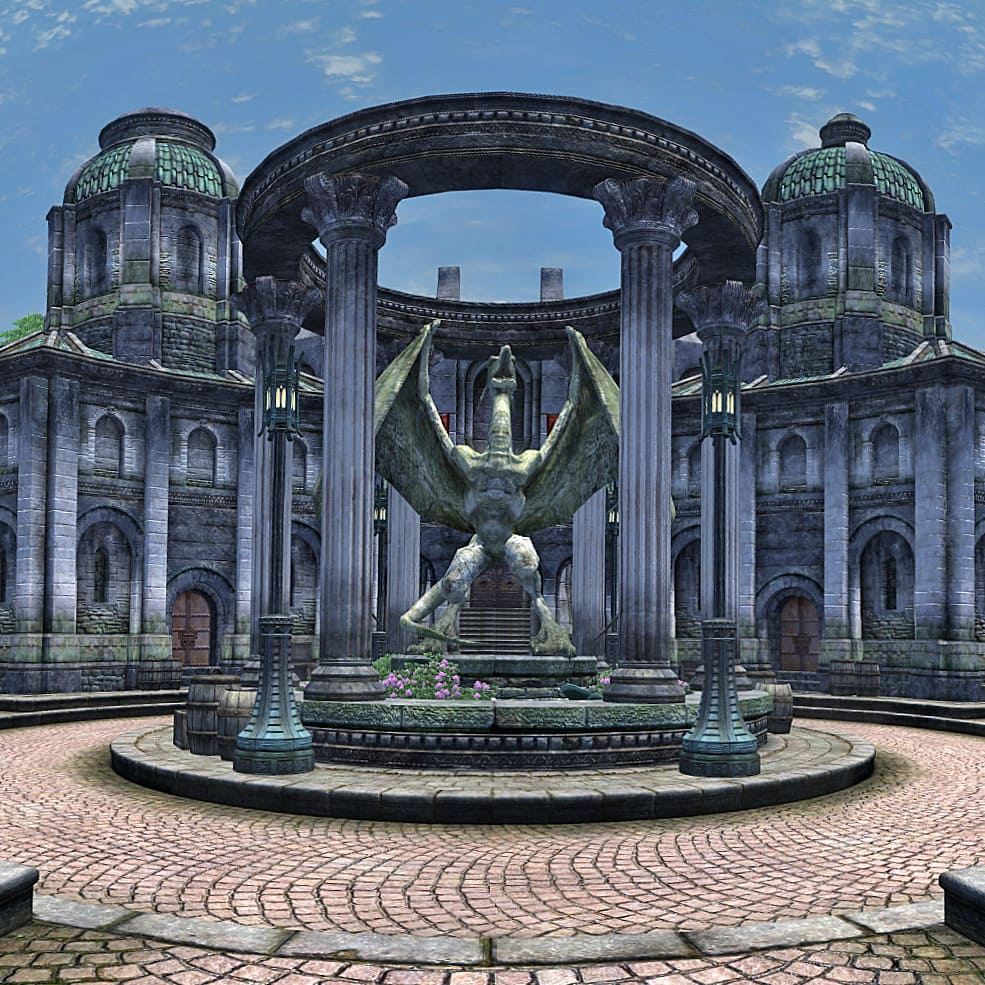 Oblivion Oblivion
|
 Oblivion Oblivion
|
 Blades Blades
|
 Oblivion Oblivion
|
||||
| A large statue of Akatosh, wings outstretched, could be found at the center of the Talos Plaza District in the Imperial City during the late-Third Era.[7]:349
Other statuary around this time depict Akatosh as a figure with the head of a human and a dragon while holding an hourglass, alluding to his sphere of Time.[8] |
Mehrunes Dagon's invasion of Tamriel culminated at the Temple of the One in the Imperial City, where Martin Septim became the avatar of Akatosh. In the form of a dragon, Martin sacrificed himself to banish Dagon from Tamriel, and his remains solidified into a vast statue of Akatosh's dragon avatar. Ocato of Firsthold declared that the dragon would stand forever as a memorial to Martin's sacrifice.[9] | Around the Fourth Era, statuettes of Akatosh could be found in temples that depict him swallowing a sword, although the symbolism of act is unclear.[10] | |||||
Arkay[edit] | |||
 ESO ESO
|
 Daggerfall Daggerfall
|
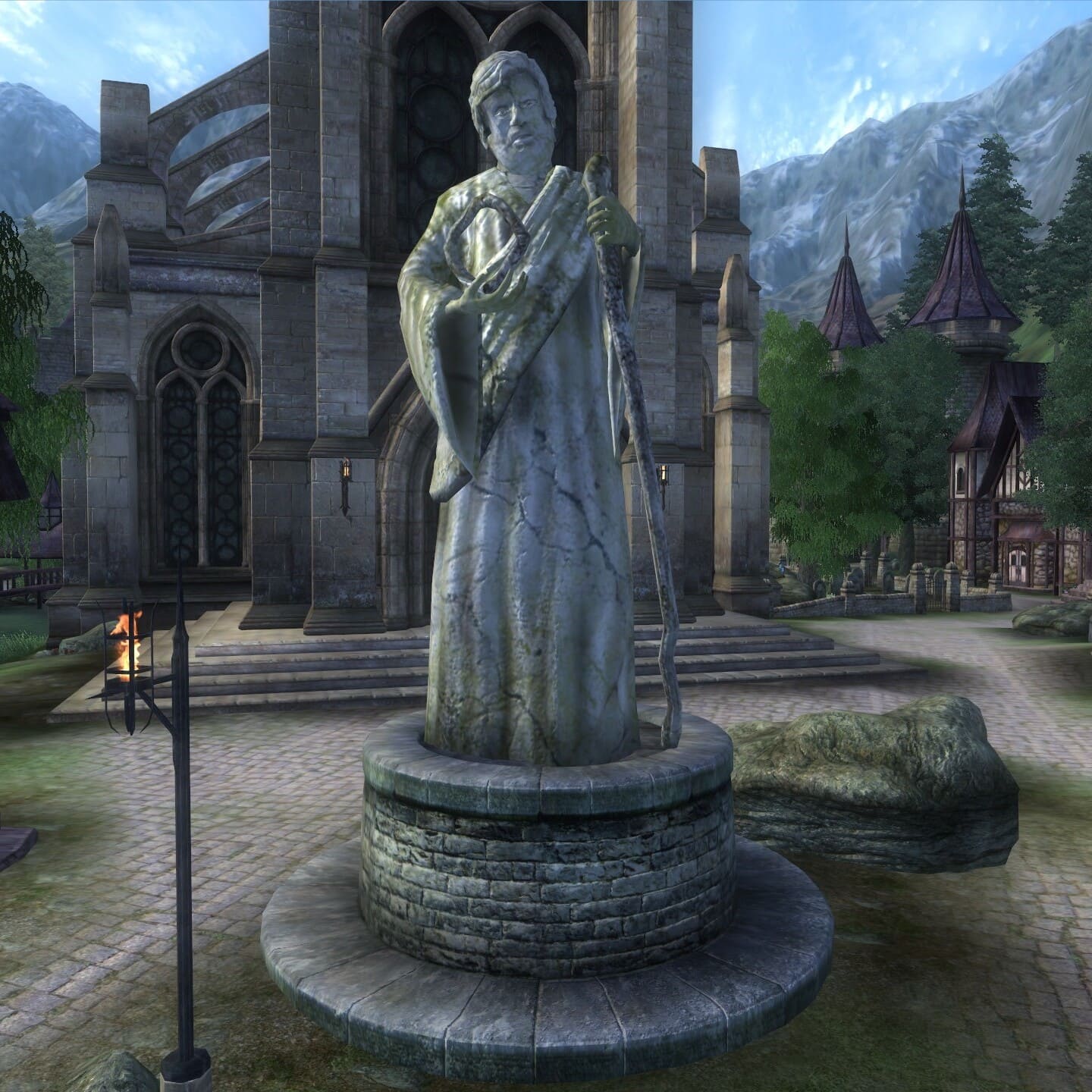 Oblivion Oblivion
|
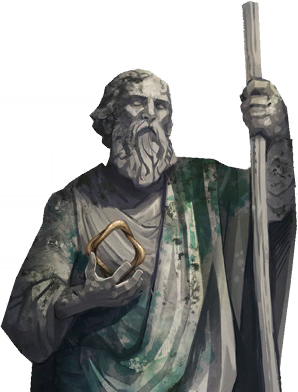 Blades Blades
|
|---|---|---|---|
|
Statuary of Arkay has remained relatively consistent throughout the eras. He is depicted as a robed, old man holding a staff in his left hand and an object in his right hand, but it's unclear if or how it relates to his sphere of burial rites and the cycle of life and death. Statues of Arkay could be found in various Breton and Imperial settlements during the Second Era and Third Eras, notably in Cheydinhal, where the Great Chapel of Arkay was built. Vast statues of Arkay could be found at the center of Breton burial grounds, such as Cath Bedraud in Glenumbra and Pelin Graveyard in Bangkorai. Arkay's faithful are also known to keep small statues of him in their homes, which they praise every morning in thanks for granting them another day.[11] | |||
Auri-El[edit] | |||
 ESO ESO
|
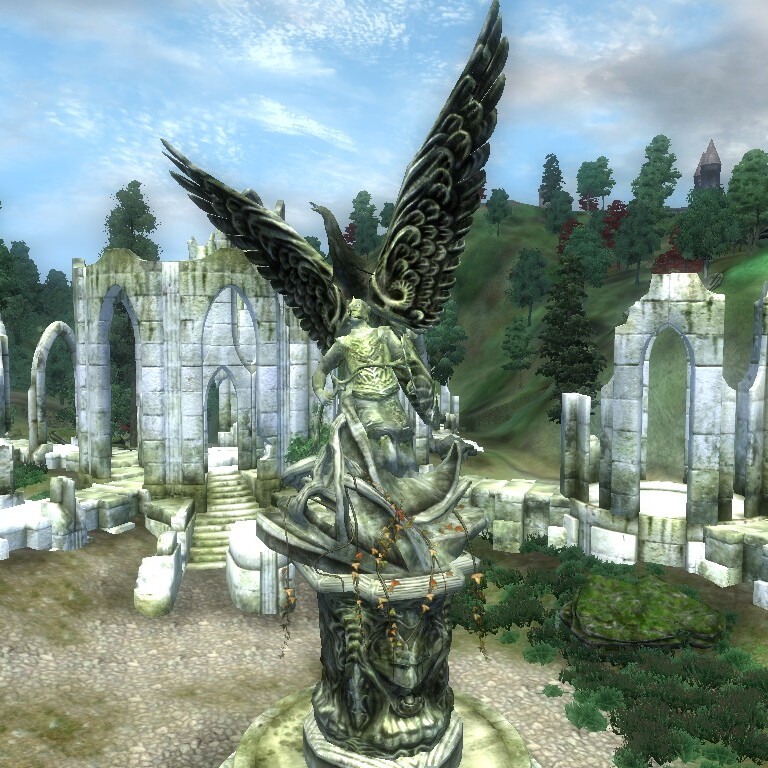 Oblivion Oblivion
|
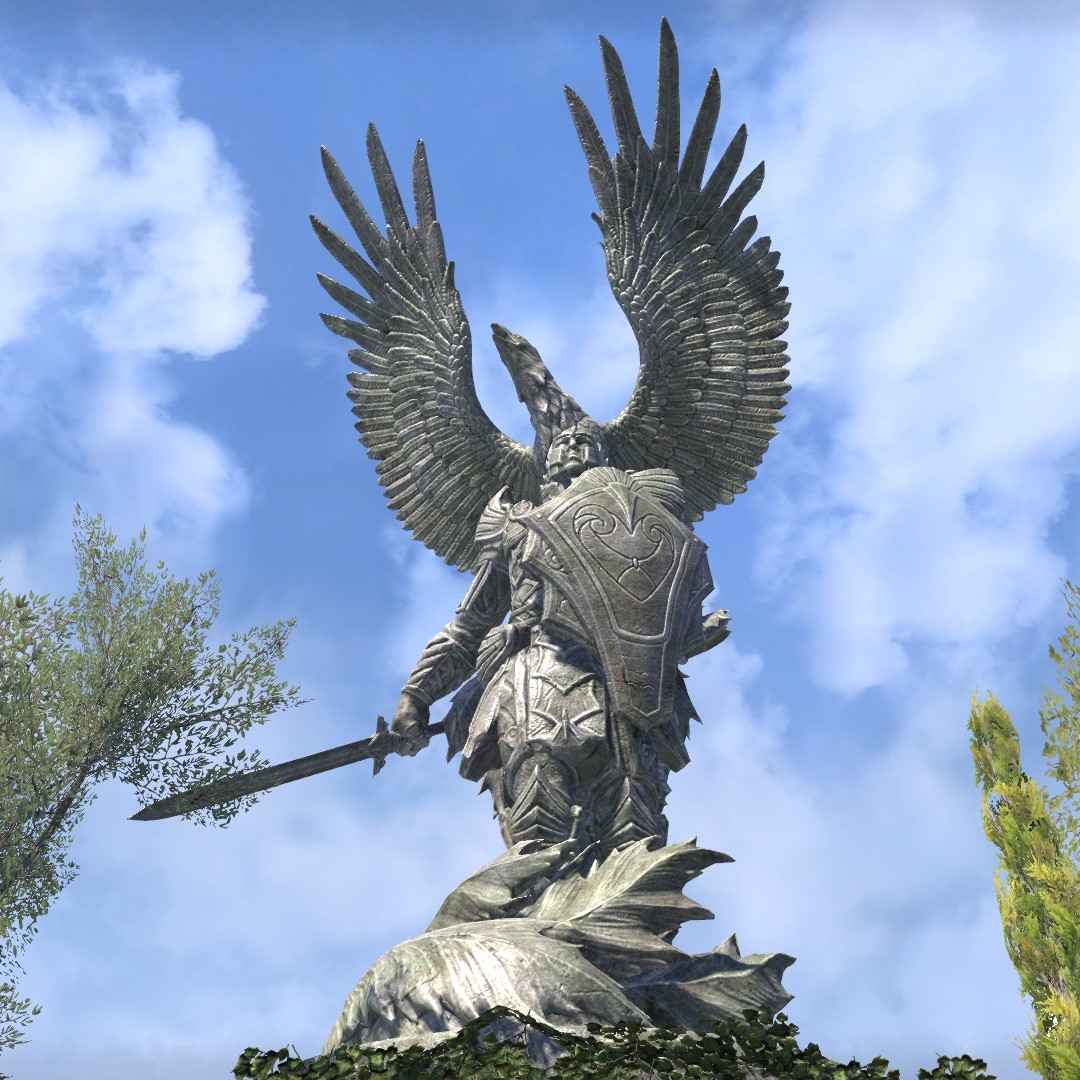 ESO ESO
|
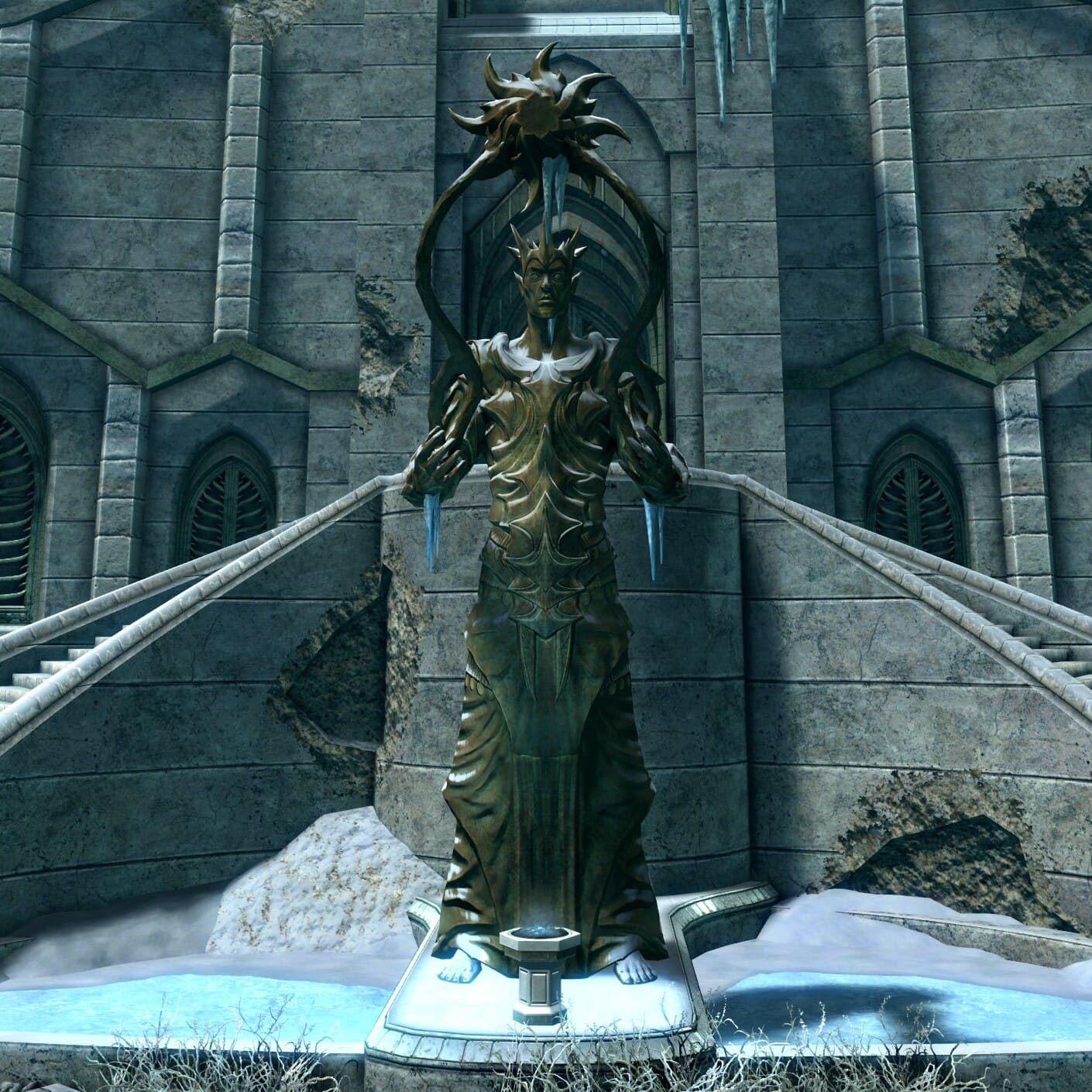 Skyrim Skyrim
|
|---|---|---|---|
| The chief Altmeri deity is depicted in a large statue found in the Monastery of Serene Harmony in Shimmerene. A crowned Auri-El stands back-to-back with Xarxes, while holding a sun-shaped sigil. | Although some Ayleids worshipped Daedra, statues of Auri-El could be in their cities across Cyrodiil. These statues depict Auri-El as a knight, holding either his bow, or a sword and shield. Behind him is a large eagle with its wings outstretched. The symbolism of this in the cultural context of the Ayleid is unclear, but it may share some parallels with Altmeri culture. For the Altmer, the high-soaring eagle represents their ancestors the Aedra, who they believe came from the heavens and were trapped in physical form by the creation of Nirn.[12][citation needed- current cite provides no link] As such, other statuary or effigies related to Auri-El heavily feature the eagle motif.[13][14][15] | Statuary from the ancient Snow Elves is exceedingly rare, but one surviving example found in the Chantry of Auri-El depicts their chief deity almost identical to Aldmeri statuary - A crowned figure holding holding aloft a sun-shaped sigil. | |
Dibella[edit] | ||||
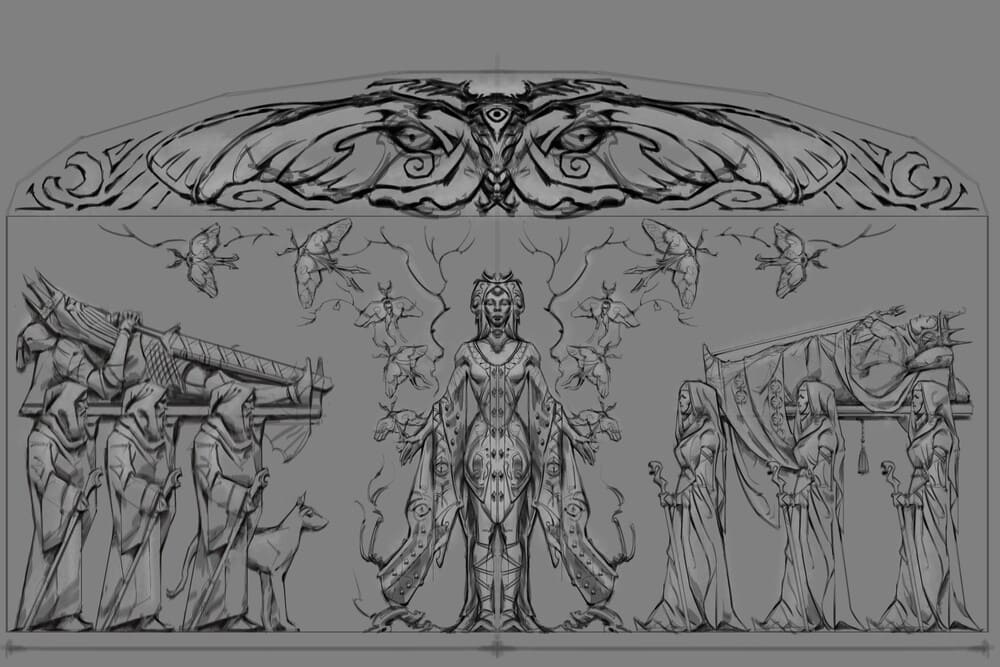 Skyrim Skyrim
|
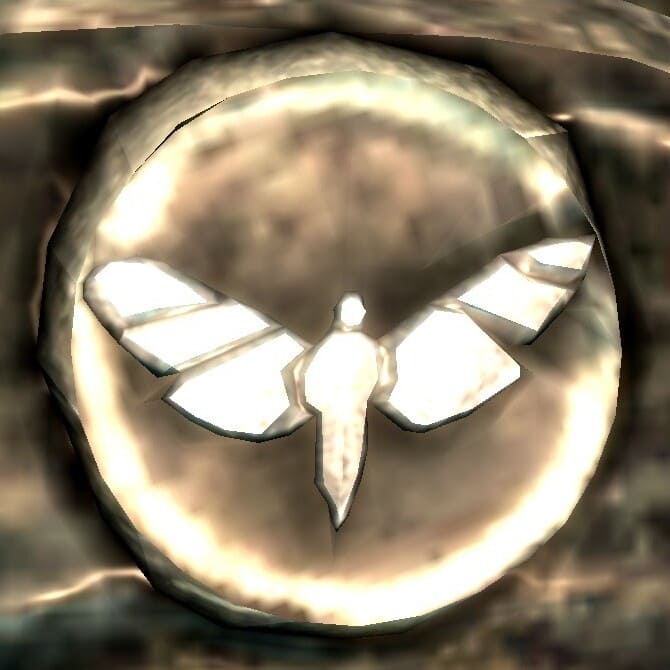 Skyrim Skyrim
| |||
|---|---|---|---|---|
|
In the totemic religion of Atmora, the precursor to the Nordic pantheon, Dibella was represented by the Silver Moth. During the Merethic Era, various depictions of the moth could be found in temples and tombs in honor of the Goddess of Beauty. [16][17] | ||||
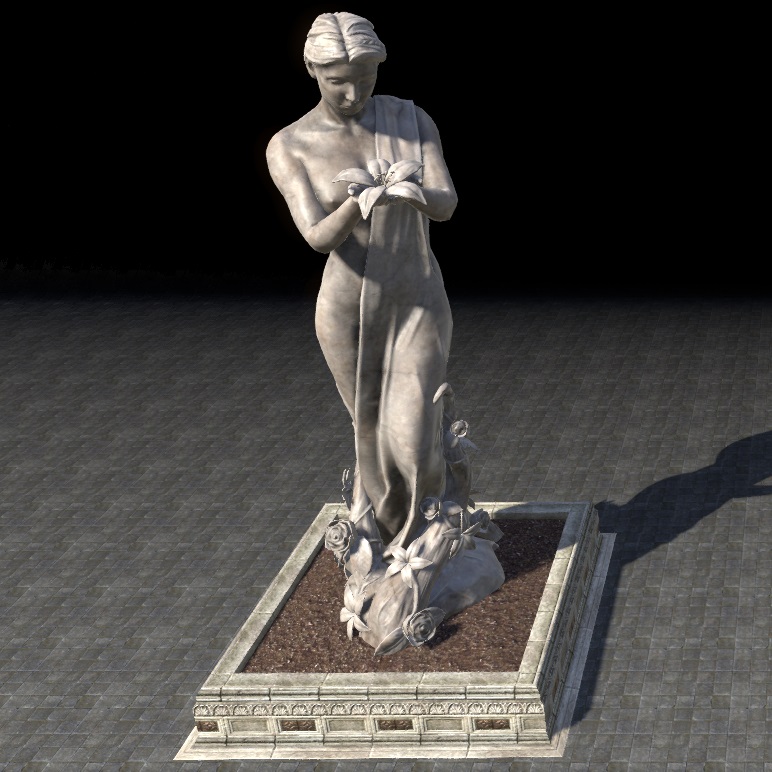 ESO ESO
|
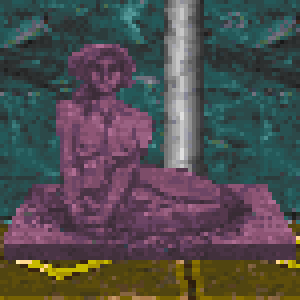 Daggerfall Daggerfall
|
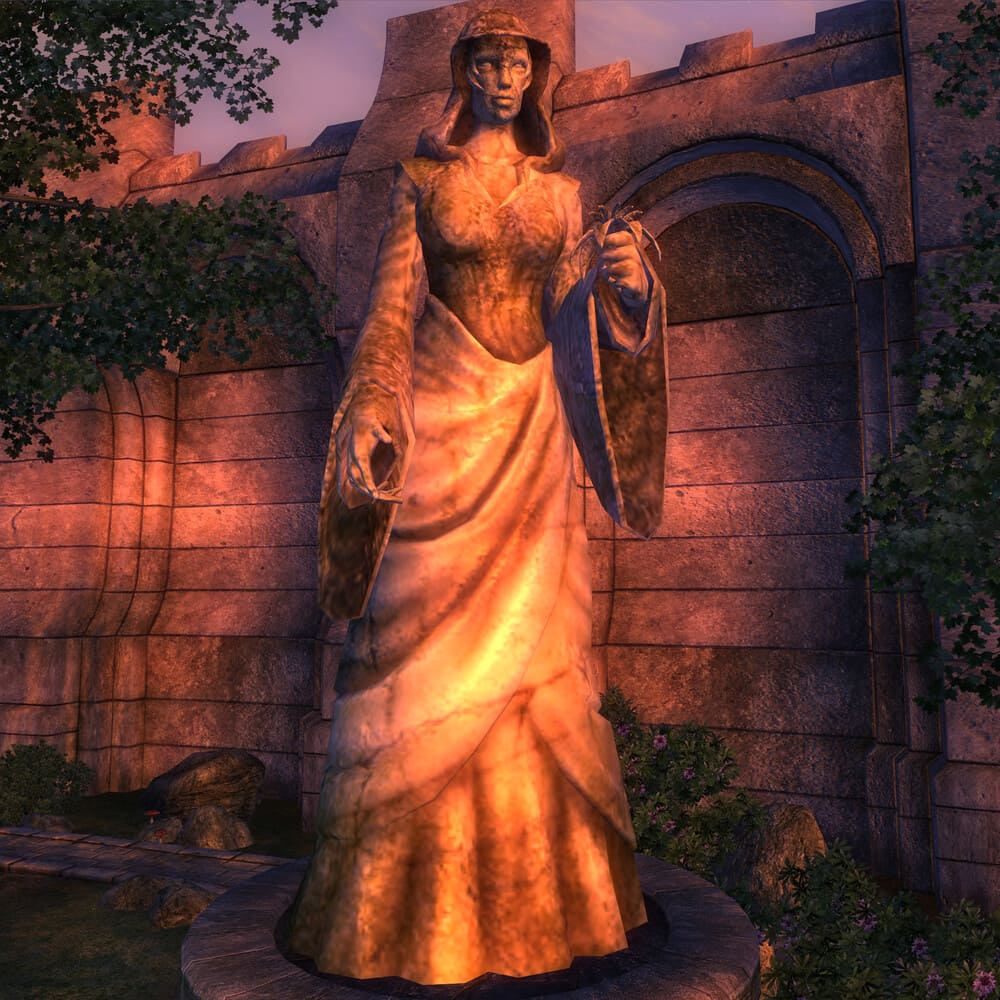 Oblivion Oblivion
|
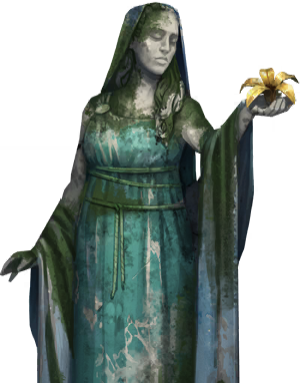 Blades Blades
|
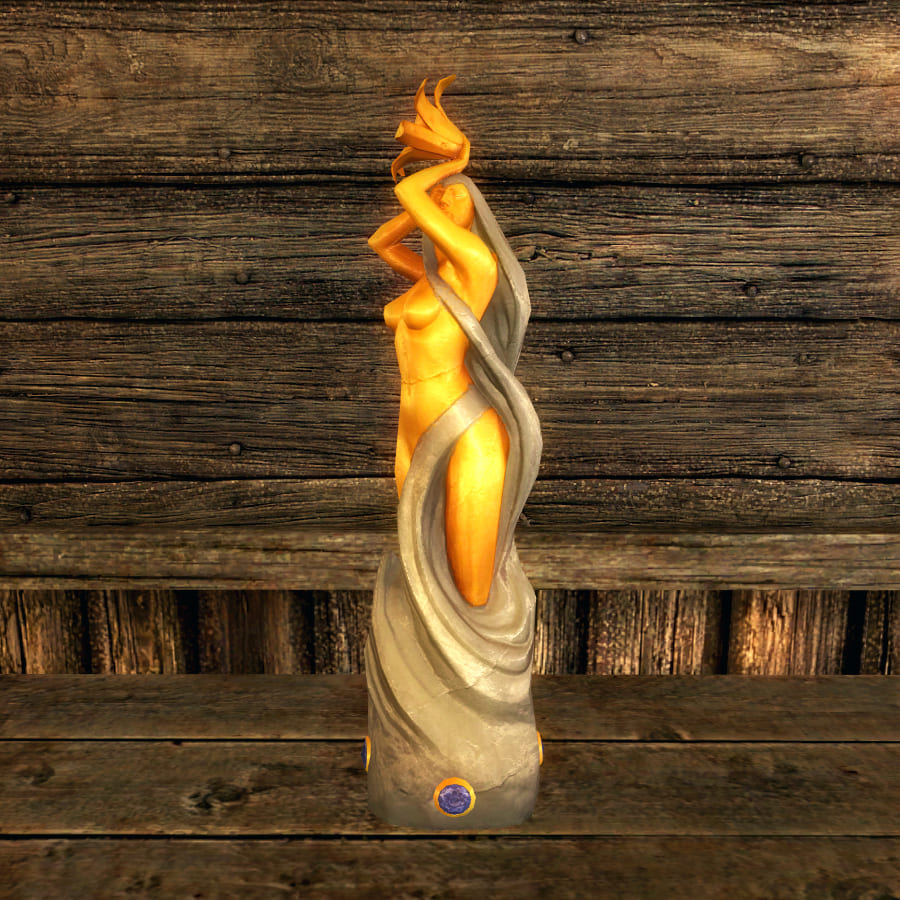 Skyrim Skyrim
|
|
In the early First Era, Alessia fused the Nordic pantheon with the Aldmeri pantheon to create the Eight Divines.[18][19] Over time, Dibella took on a more feminine form, and Nordic, Breton and Imperial statuary characterized Dibella in a similar manner - as a beautiful, scantily-clad woman. Sometimes she held a flower in her hands, which itself became a symbol for the Lady of Love.[20][21] Dibella also became associated with amorous activities and numerous types of statuary reflected this, including ceramic or alabaster statuettes that were kept in Nordic bedchambers to enhance nightly endeavors.[22][23][24][25] Other examples include carved soapstone idols of Dibella that were said to increase the holder's romantic appeal if regularly burnished.[26] | ||||
Jephre[edit] | |
|
According to Elven legends, Jephre the Singer walked among the early Elves and gave heed to the nature of the forests. He taught the birds to sing their songs, the streams their ethereal tune, and taught the Elven youth songs that led to the first great ballads. In later eras he became worshipped as the god of song and forest among the Altmer and shrines to Jephre, such as the one found in the Monastery of Serene Harmony on Summerset Isle, depicts a lyre to honor their ancestor.[27] |
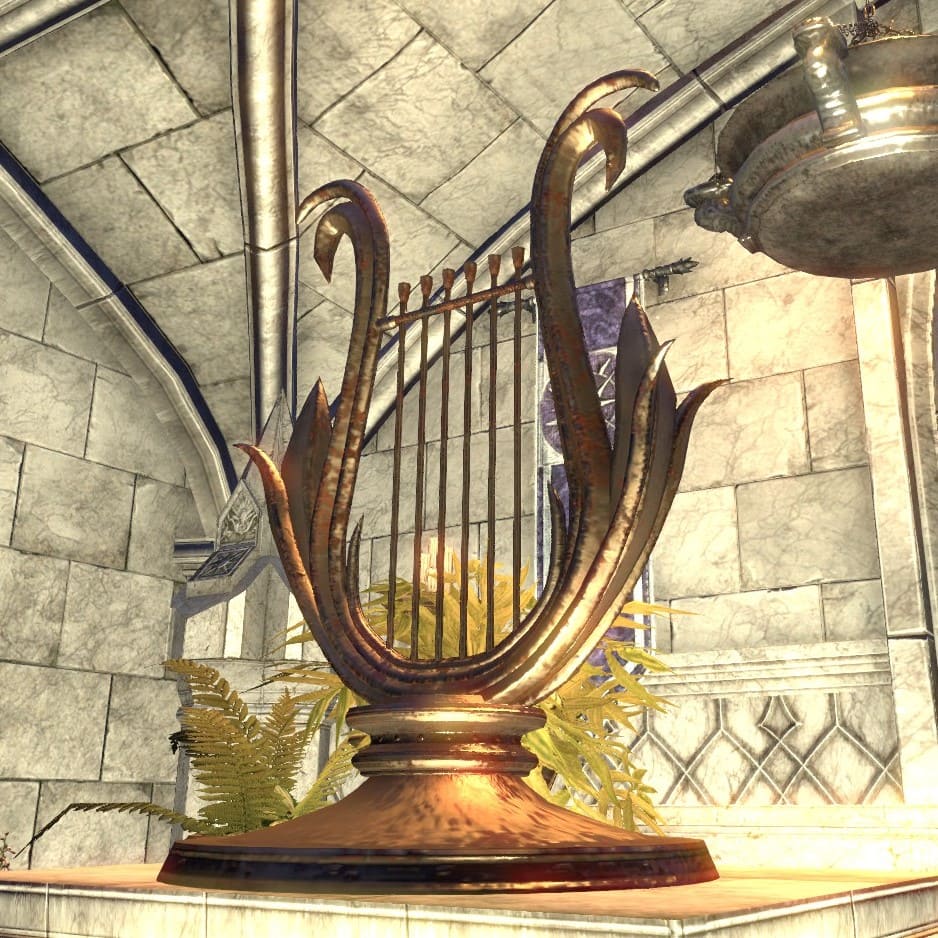 ESO ESO
|
Jhunal[edit] | |
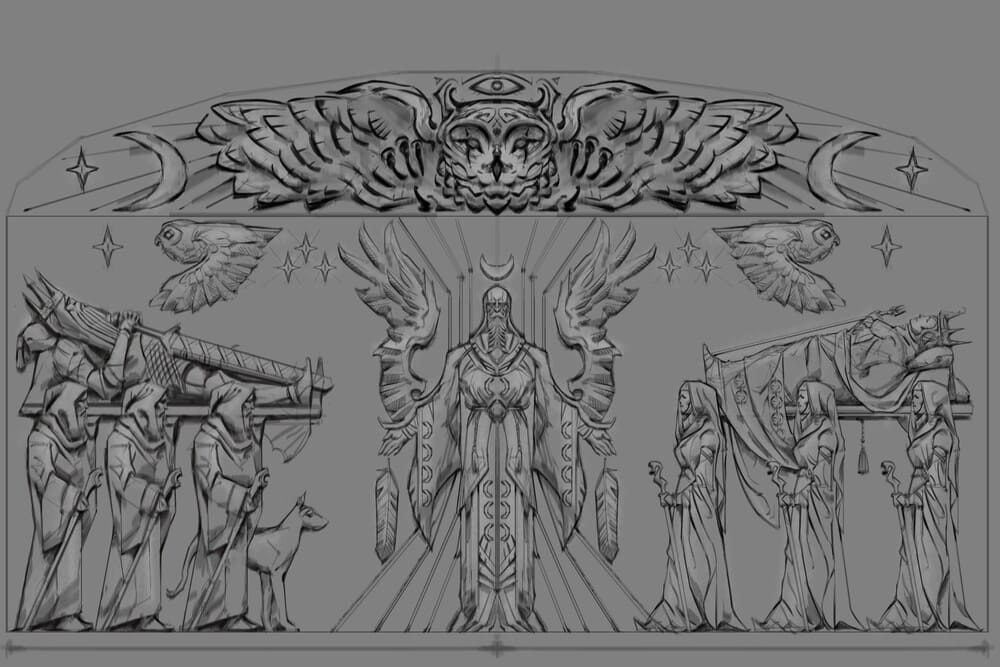 Skyrim Skyrim
|
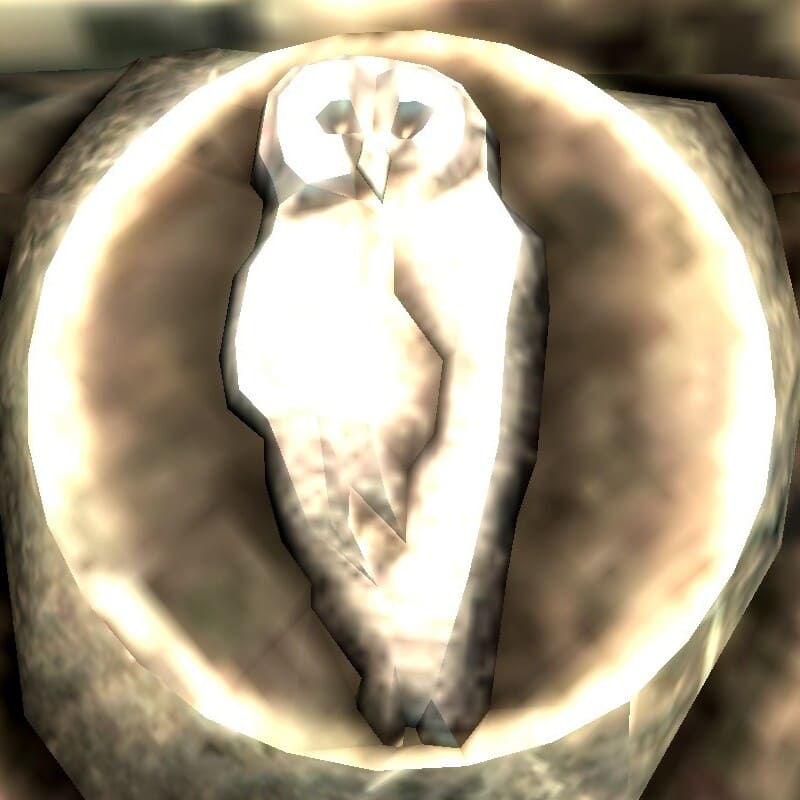 Skyrim Skyrim
|
|---|---|
|
Jhunal was represented by the Owl under the animalistic religion of Atmora.[28] During the Merethic Era the ancient Nords created various totemic depictions of the owl (or figures bearing owl-like imagery) in veneration of the rune god, which could be found in temples and tombs across Skyrim.[16][17] Jhunal eventually fell out of favor among Nords and became known as Julianos when the Nordic faith shifted towards the Divines.[29] | |
Julianos[edit] | ||
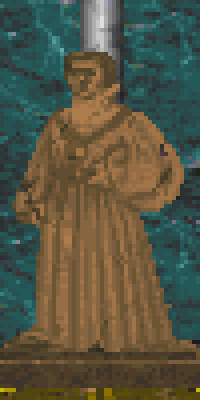 Daggerfall Daggerfall
|
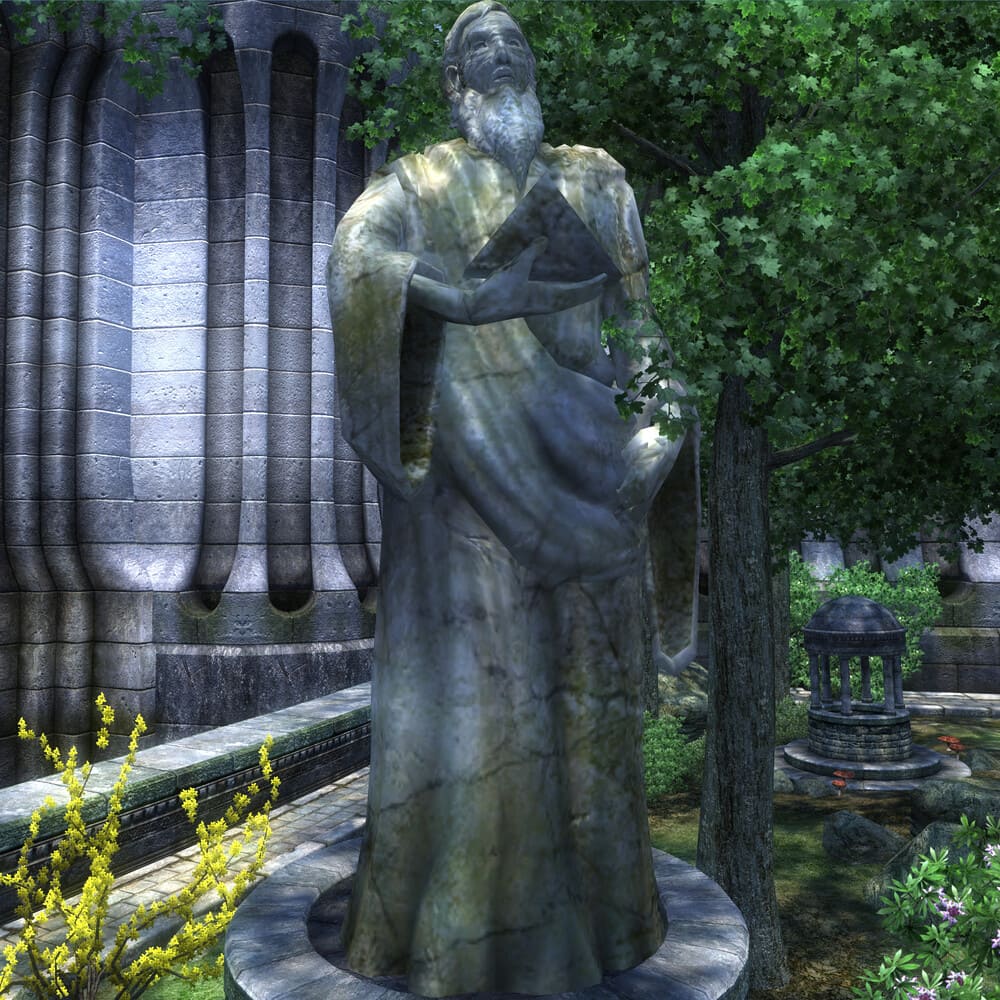 Oblivion Oblivion
|
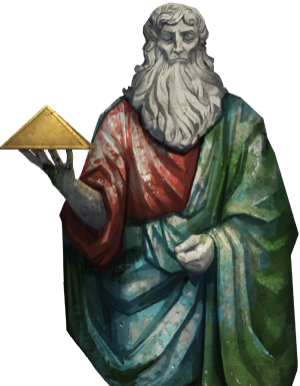 Blades Blades
|
|---|---|---|
|
Statuary of Julianos has remained relatively consistent throughout the eras. He is depicted as a robed, old man holding a pyramid-shaped object in his right hand, but it's unclear if or how it relates to his sphere of scholarship, logic and justice. Statues of Julianos could be found in various Breton and Imperial settlements during the Third Era, notably in the Arboretum District of the Imperial City.[8] In the Iliac Bay, his temples were referred to as schools and operated more like learning institutions, whereas more traditional places of worship (such as the Great Chapel of Julianos in Skingrad) were more common in Cyrodiil.[30] | ||
Kyne[edit] | |||
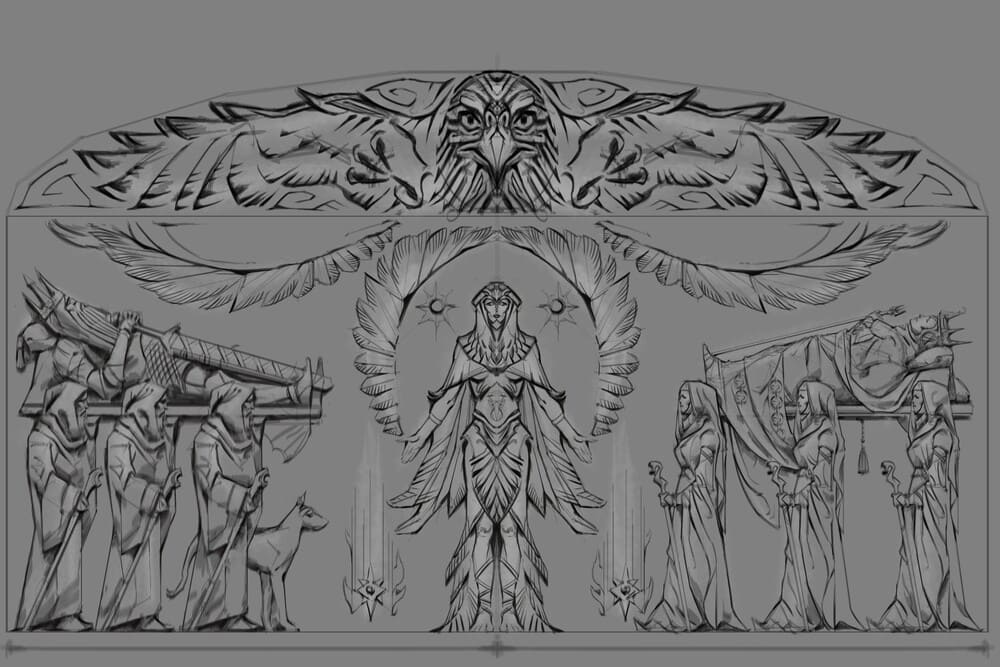 Skyrim Skyrim
|
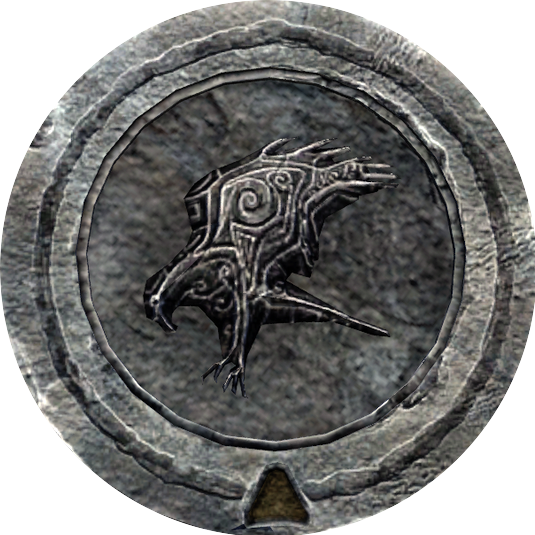 ESO ESO
|
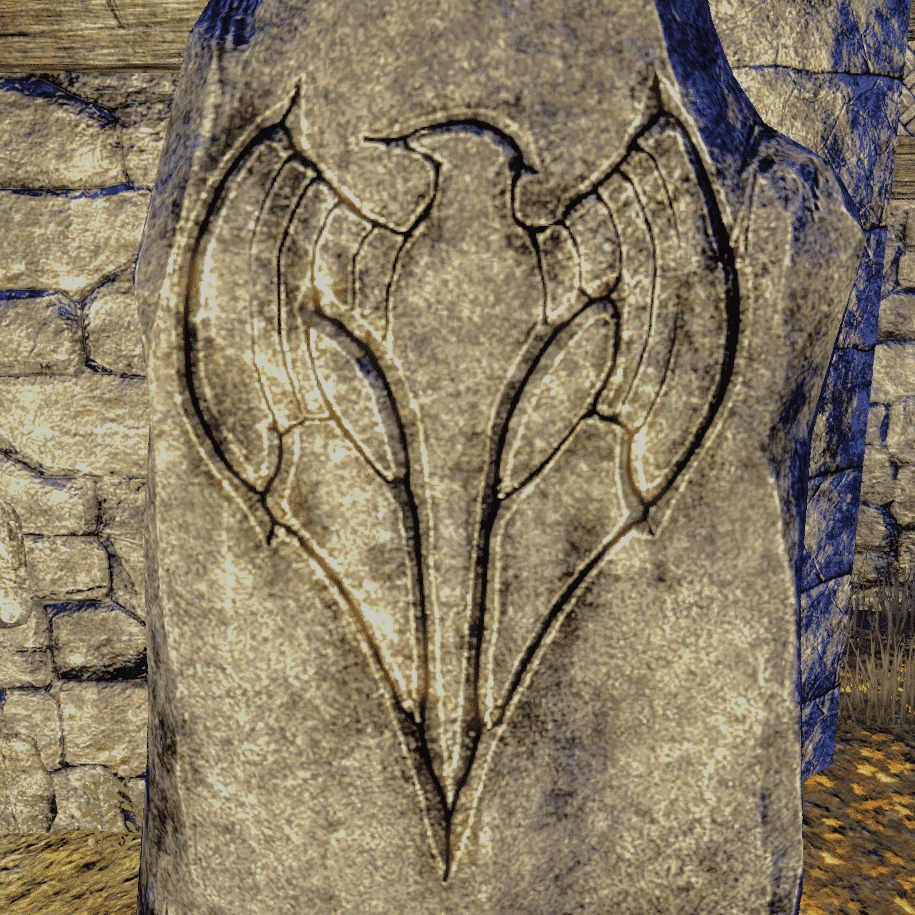 ESO ESO
| |
|---|---|---|---|
|
Kyne was represented by the hawk under the animalistic religion of Atmora. During the Merethic Era the ancient Nords created various totemic depictions of the hawk (or figures bearing hawk-like imagery) in veneration of the Goddess of Storm, many of which could be found in temples and tombs across Skyrim.[16][17][nb 1] Although the worship of Kyne eventually fell out of favor among Nords, and she became known as Kynareth when the Nordic faith shifted towards the Divines, imagery of the hawk remained culturally relevant in the following eras and could be seen in their art, architecture, and armor.[31][29] This included depictions of Kyne found in snow-white wood carvings engraved with whorls and jagged lines.[32] | |||
Kynareth[edit] | ||||
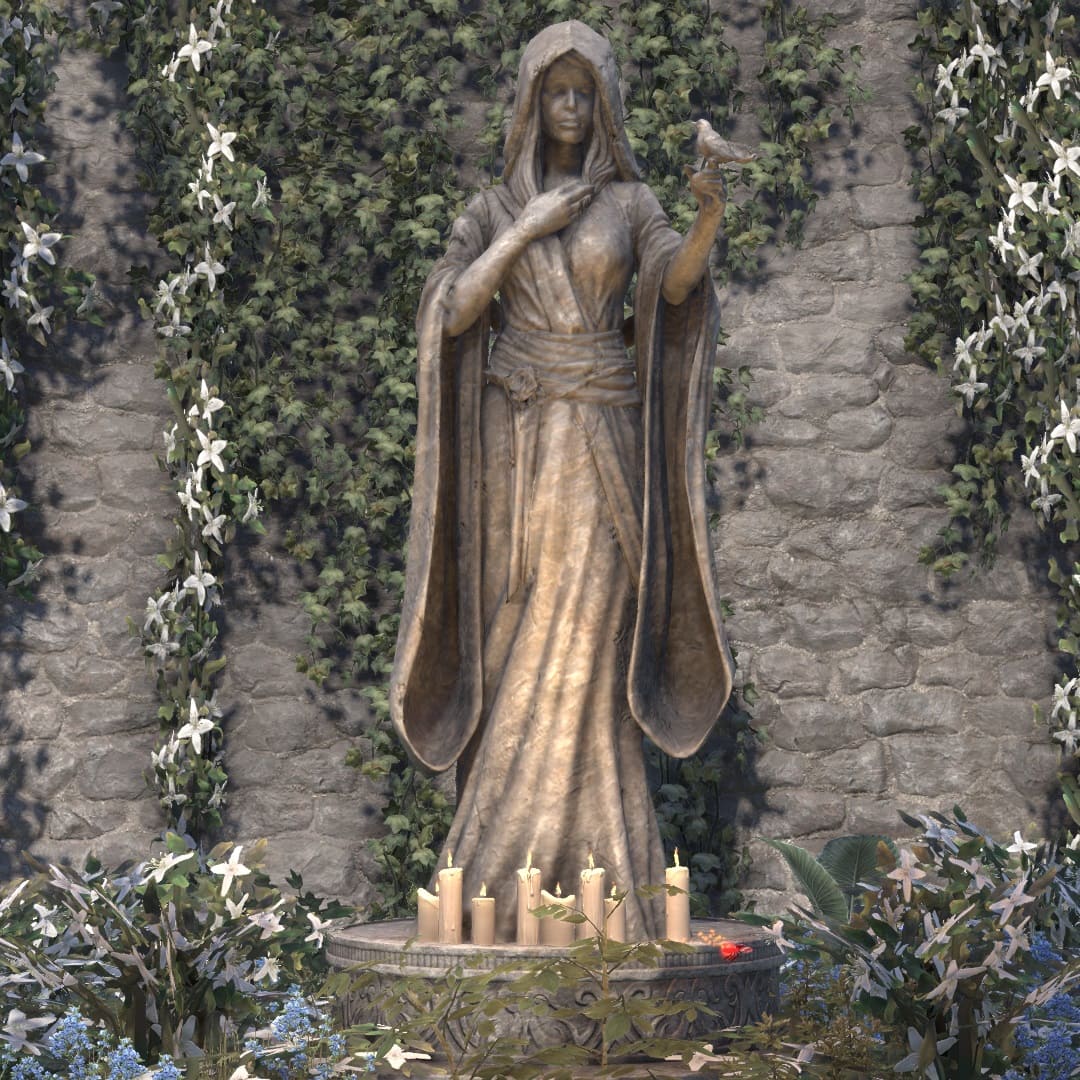 ESO ESO
|
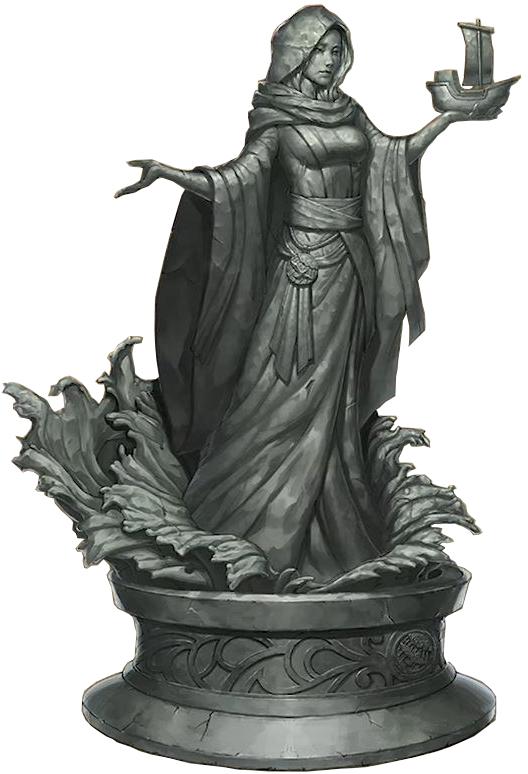 ESO ESO
|
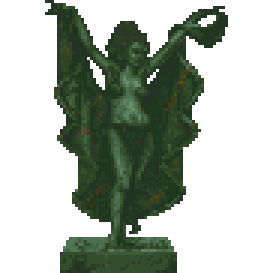 Daggerfall Daggerfall
|
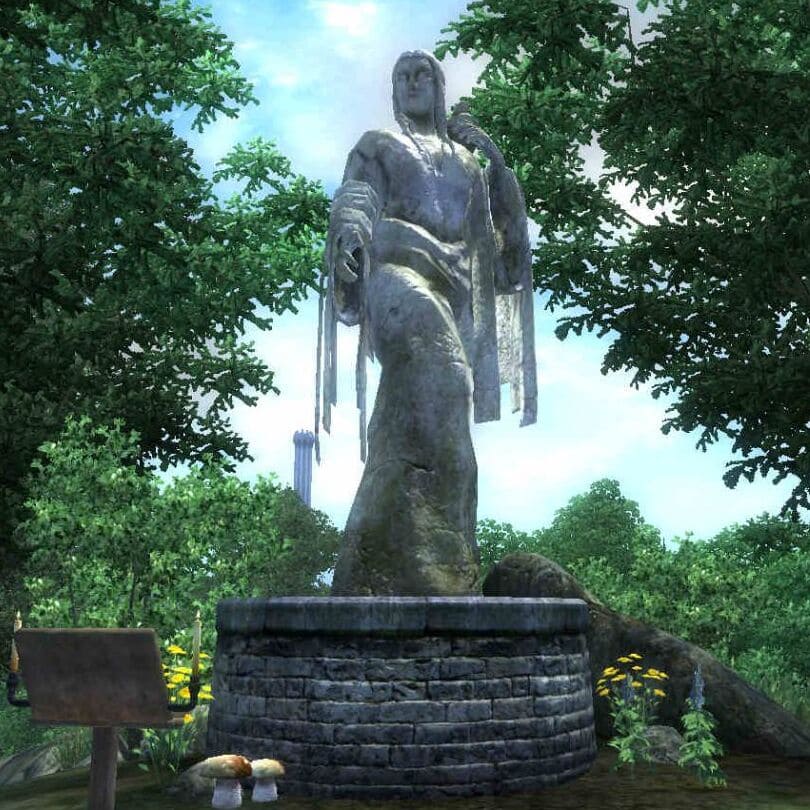 Oblivion Oblivion
|
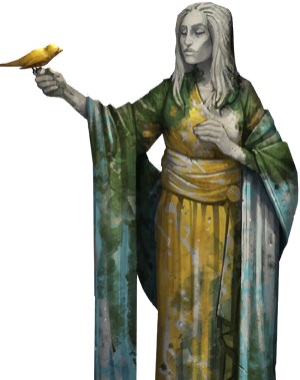 Blades Blades
|
|---|---|---|---|---|
|
Worship of Kynareth became prevalent after Alessia fused the Nordic pantheon with the Aldmeri pantheon to create the Eight Divines in the early First Era.[29][18] As such, Kyne became known as Kynareth, and the hawk-like imagery of Kyne became less apparent among Nords. Statuary representing Kynareth characterized her as a young woman in robes, sometimes holding a small bird[33] or a ship[34] - particularly in Imperial and Breton cultures. In the Systres, she was commonly depicted as a small bird wearing a crown.[35] Over time, Kynareth became associated with the sea, the elements, and the unseen spirits of the air.[36] | ||||
Magnus[edit] | |
|
An Altmeri shrine to Magnus, god of Magic, was found in the Monastery of Serene Harmony on Summerset Isle. Here Magnus is represented by an ornate astrolabe, however other times he is represented as a telescope or more commonly, a staff.[29] Cults of Magnus were known to create wicker effigies that they would use as a stand-in for the owner in certain rituals.[37] |
 ESO ESO
|
Mara[edit] | ||||||
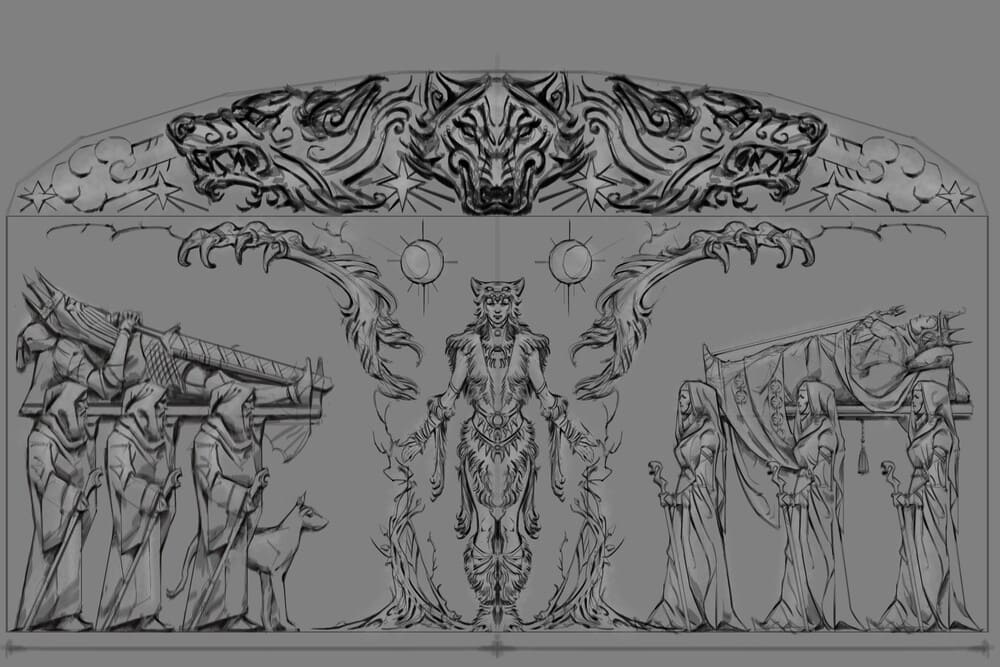 Skyrim Skyrim
|
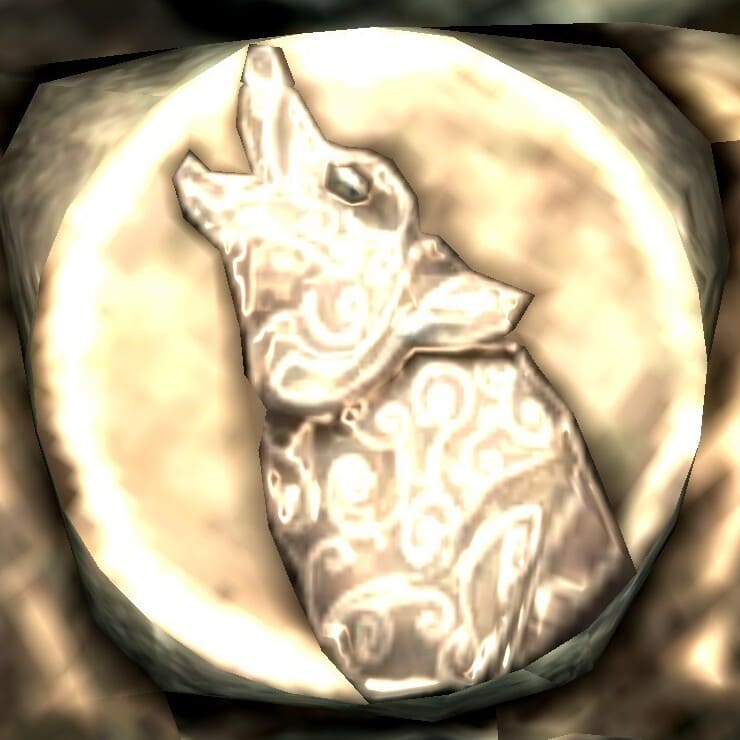 Skyrim Skyrim
| |||||
|---|---|---|---|---|---|---|
|
Mara was represented by the wolf under the animalistic religion of Atmora. During the Merethic Era the ancient Nords created various totemic depictions of the wolf (or figures bearing wolf-like imagery) in veneration of Kyne's handmaiden, which could be found in temples and tombs across Skyrim.[16][nb 2] This included depictions of Mara in stone and wooden carvings as a naked woman partially clothed in wolf pelts, bearing her own fangs.[38] Known to the Nords as Mother Wolf, Mara represented prosperity, fertility and blessed their sacred flora.[39][17][29] | ||||||
 Daggerfall Daggerfall
|
 Oblivion Oblivion
|
 Castles Castles
|
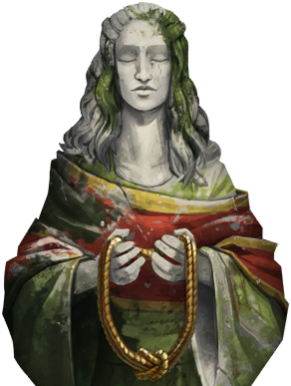 Blades Blades
|
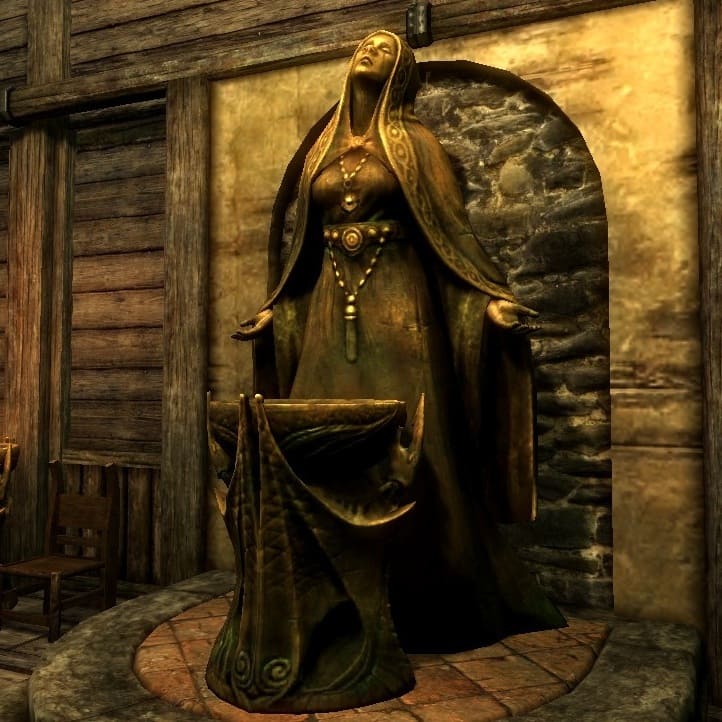 Skyrim Skyrim
|
||
|
After Alessia fused the Nordic pantheon with the Aldmeri pantheon to create the Eight Divines, Mara took on a more feminine form as reflected by Nordic and Imperial statuary, which characterised her as a robed mother holding a knotted rope. Mara also became associated with marriage, and wedding ceremonies would typically take place in her temples in Nordic lands.[40] Mara's cross, typically found on her shrines and altars, also depict the Goddess of Love and is strongly associated with bonding, love and intimacy.[41][42] Numerous types of statuary, such as flower-spouting fertility statuettes, reflected her role as the Mother-Goddess.[43] Mara was known to the Redguards as Morwha, an ancient Yokudan fertility goddess. Although Morwha and Mara are used interchangeably among the Forebears, their statuary varies as Morwha is always depicted with four arms so that she may "grab more husbands".[44] | ||||||
Morwha[edit] | |
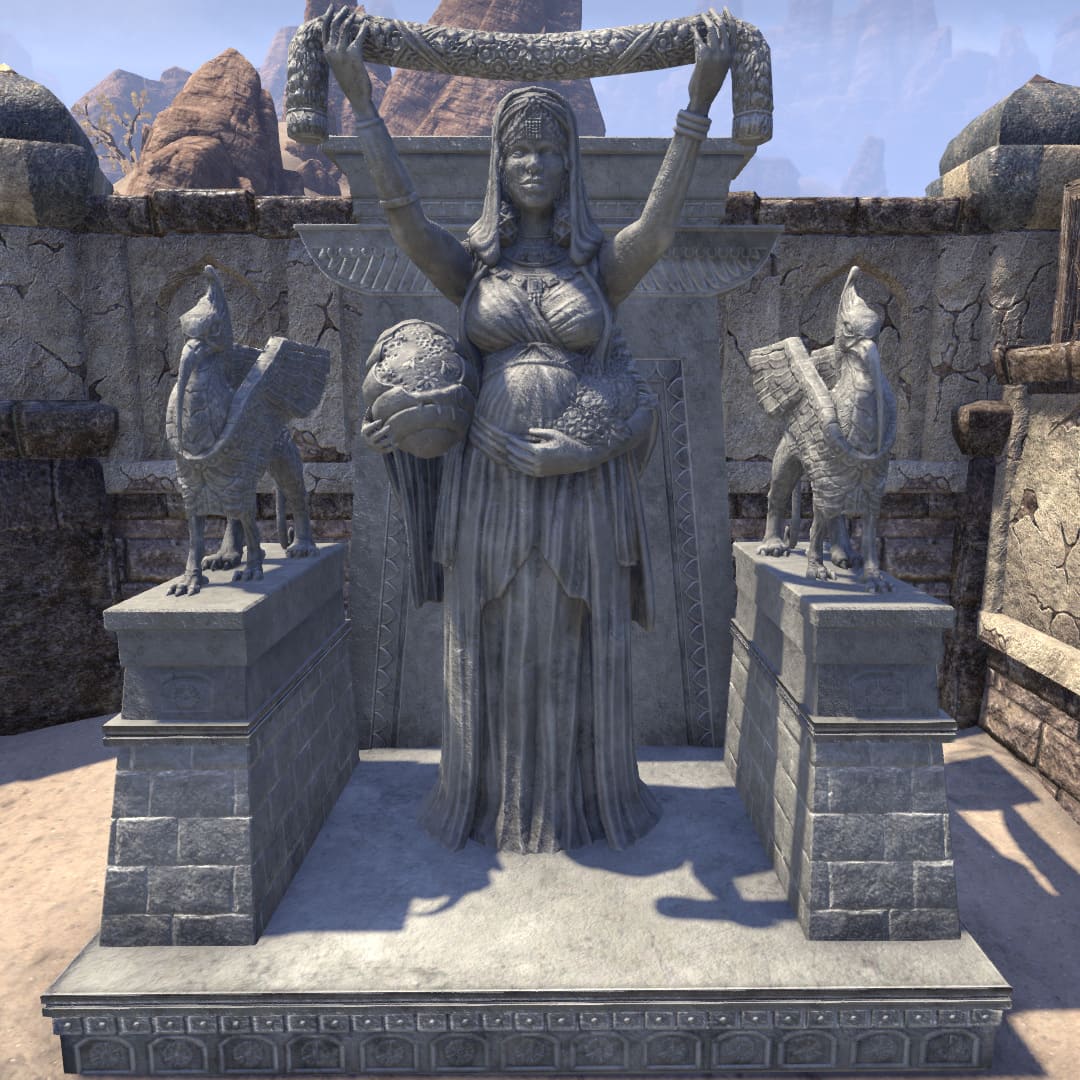 ESO ESO
|
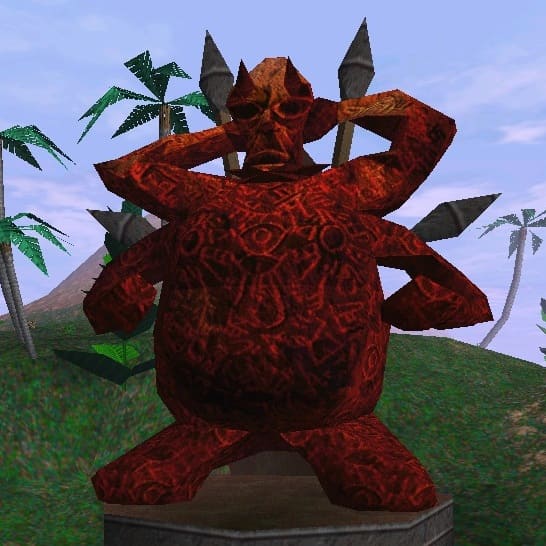 Redguard Redguard
|
|---|---|
|
A large alabaster statue of Morwha enshrined and flanked by winged guardians was uncovered in the mid-Second Era by the Antiquarian Circle in Hew's Bane. Typical of Morwha statuary, she is portrayed as four-armed so that she can "grab more husbands", according to Yokudan mythology.[29] The alabaster material that the statue was built from was not typical for Yokudan statuary, leading scholars to speculate that the stone was acquired during the early days of the Ra Gada and their conquest of the Lefthanded Elves.[45] |
Another four-armed statue of Morwha was built of the island of Stros M'Kai near Saintsport, although this depiction was highly stylized compared to traditional statuary. Despite depicting Morwha, it was sometimes conflated with Arkay. |
Orkey[edit] | ||
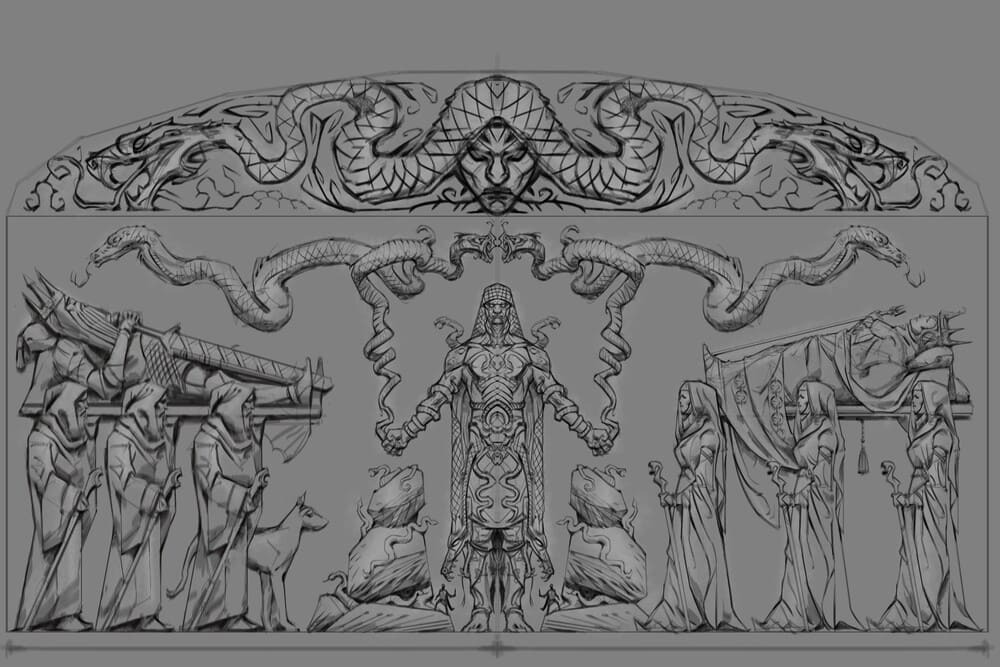 Skyrim Skyrim
|
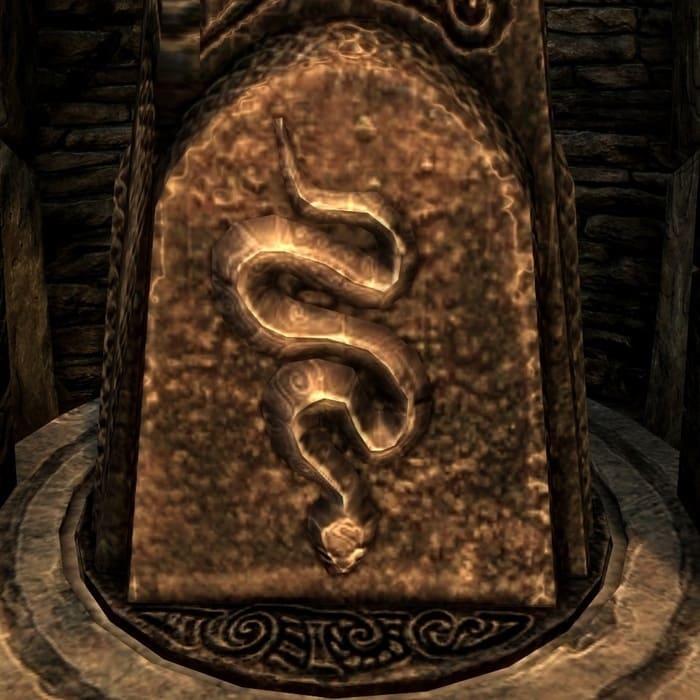 Skyrim Skyrim
|
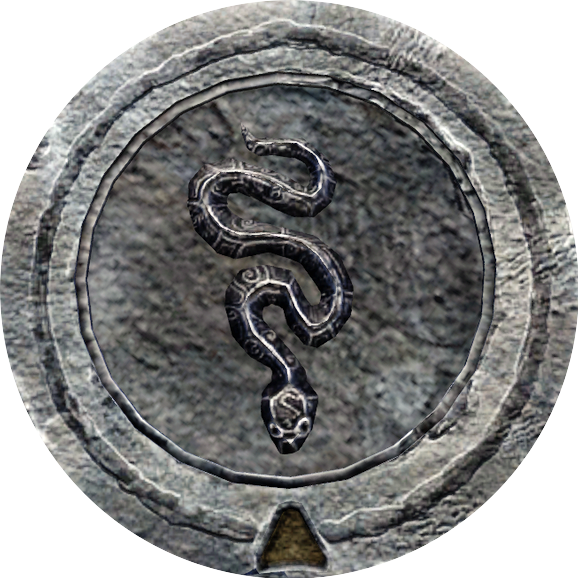 ESO ESO
|
|---|---|---|
|
Orkey was represented by the snake under the animalistic religion of Atmora. During the Merethic Era the ancient Nords created various totemic depictions of the snake (or figures bearing snake-like imagery) in veneration of the god of mortality, many of which could be found in tombs across Skyrim.[17] Considered a "testing god" by the Nords, Orkey was said to have been worshipped in ancient times, but this eventually waned, especially after the Nordic faith shifted towards the Divines in the early-First Era.[16] Instead, the Nords guard against Orkey in order to protect the hearth, and try to keep him appeased by keeping small statues in their homes that depict him.[46][47] According to some scholars, Orkey was fused with aspects of the Elven deity Xarxes and became known as Arkay thereafter.[48] Others suggest Orkey combines aspects of Mauloch and Arkay.[47] Regardless, iconography of the snake representing Orkey ceased among Nords, however priests of Orkey continued to exist in Skyrim up until at least the Second Era where they performed their sacred duty to the Divines in Halls of the Dead.[49] Although the snake was no longer relevant to Nordic religious imagery, the ancient Argonians heavily associated it with Sithis and it was reflected in much of their statuary. | ||
Phynaster[edit] | |
|
An Altmeri shrine to Phynaster, hero-god of the Summerset Isles was found in the Monastery of Serene Harmony on Summerset Isle. According to legend, he taught the Altmer how to naturally live another hundred years by using a shorter walking stride. To represent this feat, Phynaster's shrine depicts a decorative golden boot.[29] |
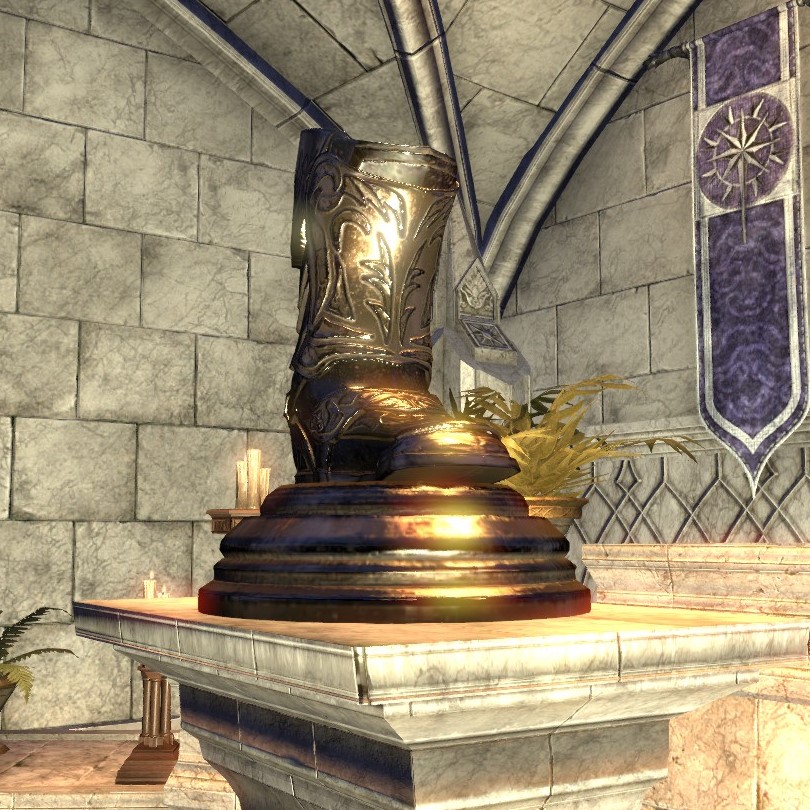 ESO ESO
|
Satakal[edit] | ||
|
A Na-Totambu ceremonial gong depicting Satakal was uncovered in the mid-Second Era by the Antiquarian Circle in the Alik'r Desert. The frame was fashioned to resemble their snake-deity devouring itself in a never-ending cycle of rebirth, according to Yokudan myth.[50] |
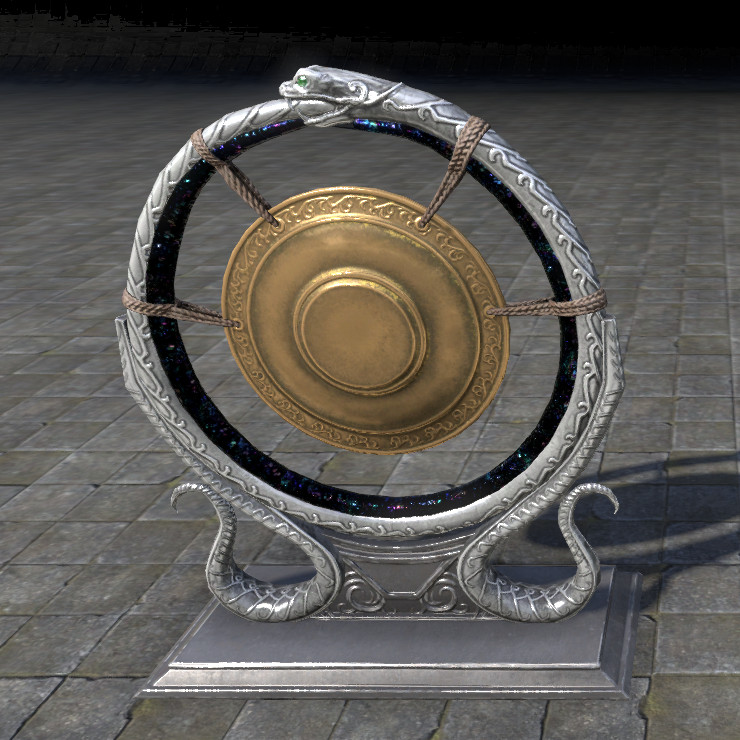 ESO ESO
| |
Shor[edit] | ||
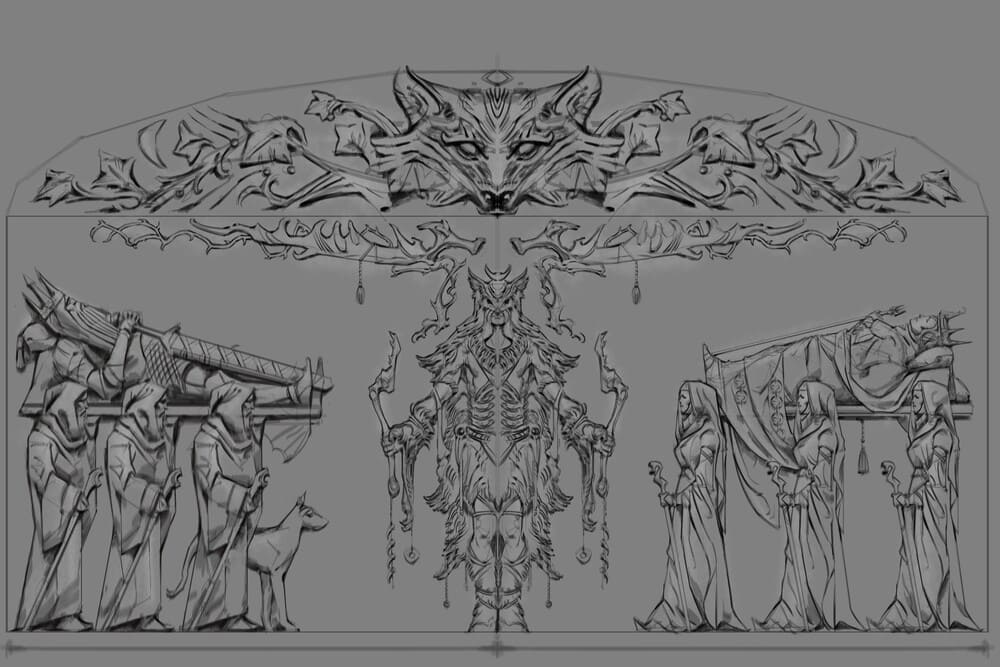 Skyrim Skyrim
|
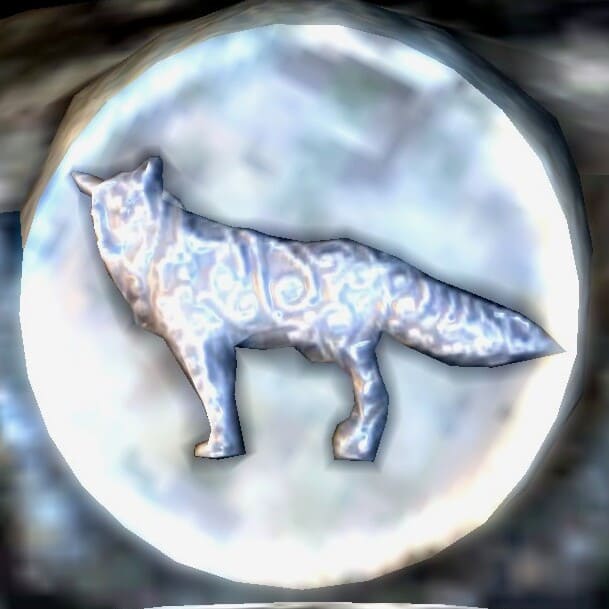 Skyrim Skyrim
|
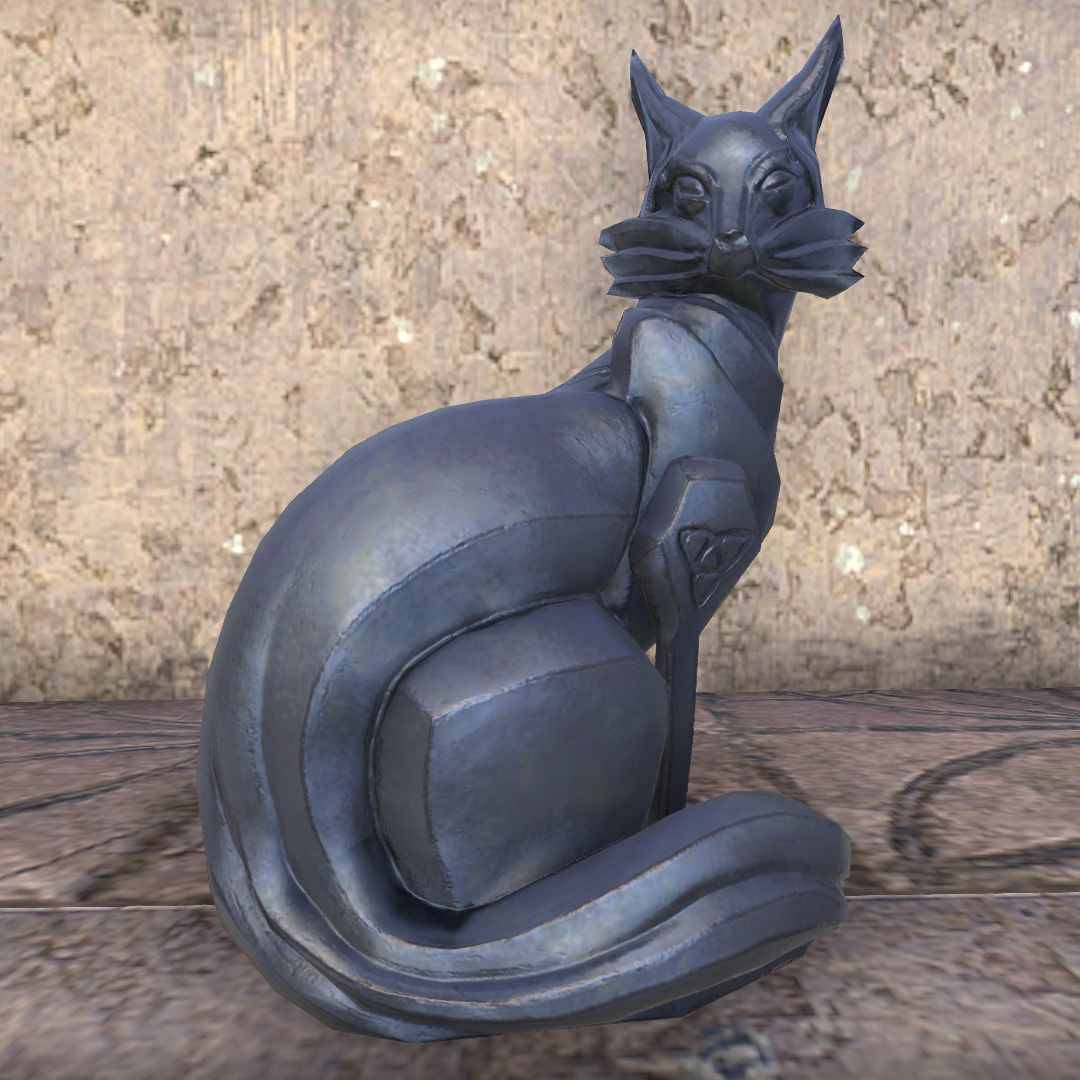 ESO ESO
|
|---|---|---|
|
Shor was represented by the fox under the animalistic religion of Atmora. During the Merethic Era the ancient Nords created various totemic depictions of the fox (or figures bearing fox-like imagery) in honor of the God of the Underworld, many of which could be found in tombs across Skyrim.[16][17] Considered to be a "dead god" who fought and died to bring about the current world, Shor was not actively worshiped compared to other Aedra in the Nordic pantheon.[47] As such, almost no direct iconography of Shor exists, although some sects, such as the Ternion Monks, still revere the fox.[51] The fox is also mentioned in Nordic folktales, such as when Ysgramor was saved from Herma Mora by Shor in the form of a fox.[52] |
An elegant Ebony Fox Totem was uncovered in the mid-Second Era by the Antiquarian Circle in Skyrim. This discovery was of particular note, given Atmoran totemic art typically featured harder edges and more abstract shapes. Historians speculated that this sculpture was possibly a result of cultural crossover with the Snow Elves, and that Ysgramor's heirs may have gone to great lengths to destroy elven-inspired items such as this.[53] | |
Stendarr[edit] | ||||
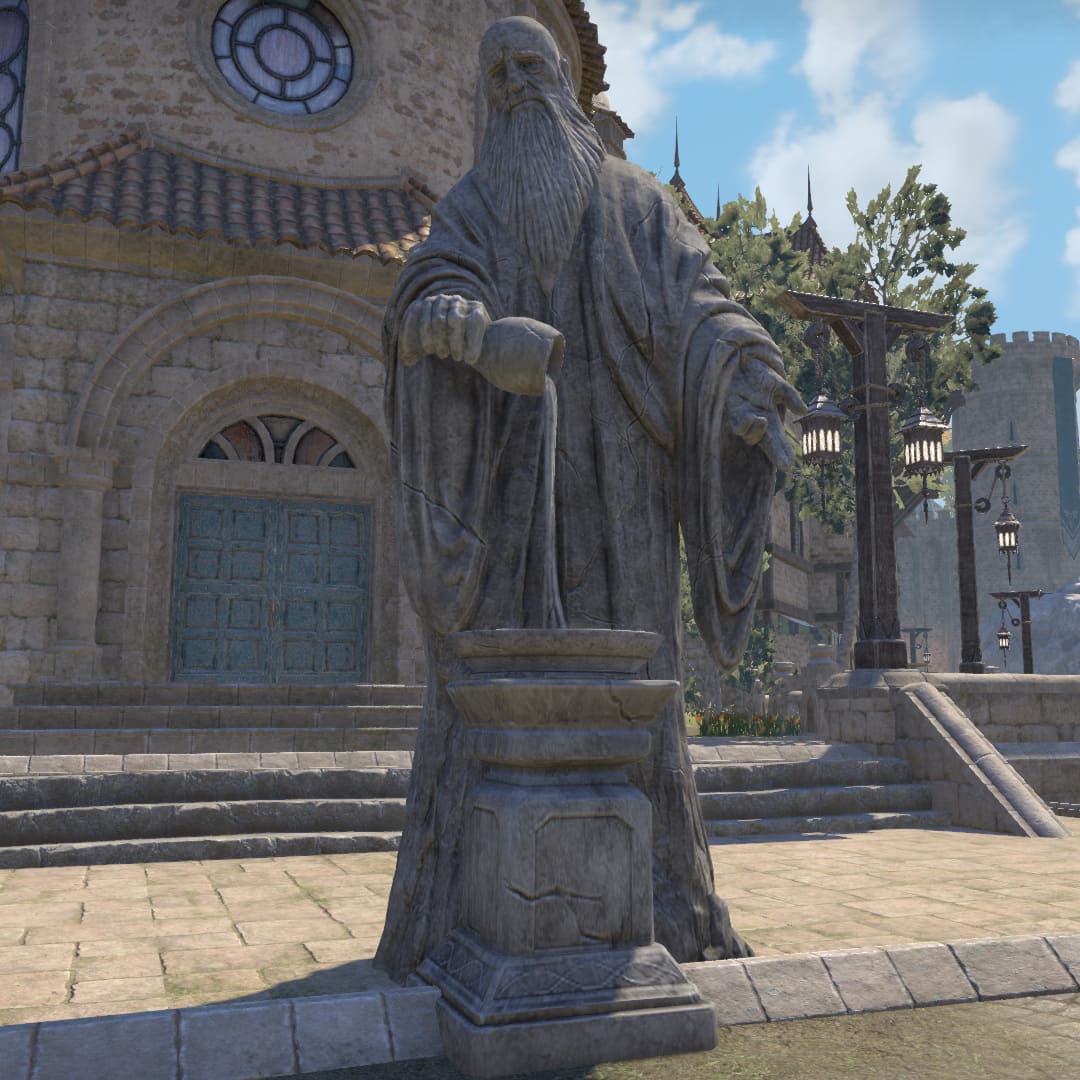 ESO ESO
|
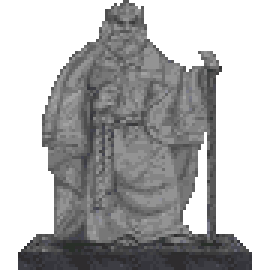 Daggerfall Daggerfall
|
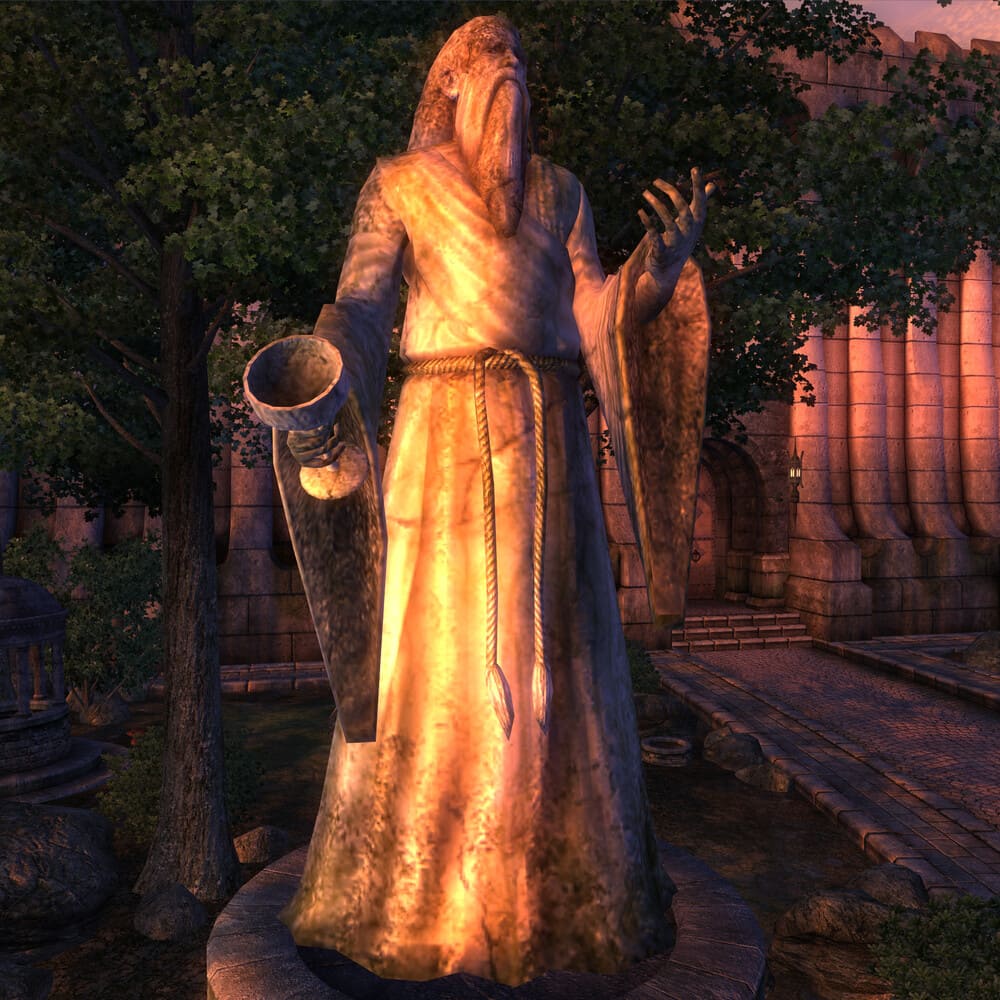 Oblivion Oblivion
|
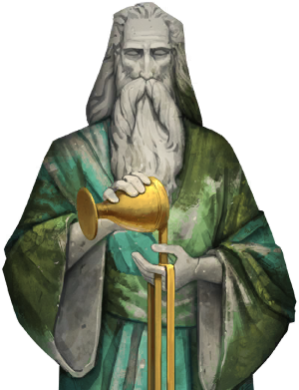 Blades Blades
|
|
|---|---|---|---|---|
|
Statuary of Stendarr has remained relatively consistent throughout the eras after his worship became established under the religion of the Divines. Prior to this, Stendarr was known in the Nordic religion as Stuhn and was associated with iconography related to the whale. Under the pantheon of the Divines, Stendarr is typically depicted as a robed, old man pouring liquid from a chalice, possibly to symbolize his sphere of charity, compassion and mercy. Shrines of Stendarr are somewhat simplified and depict only the flowing chalice or horn.[54][nb 3] Statues of Stendarr could be found in various Imperial and Breton settlements during the Second and Third Era, notably in the Arboretum District of the Imperial City and the Temple of the Winds on High Isle.[8][55] In the Iliac Bay, his temples were considered the greatest charitable institutions in the land, whereas more traditional places of worship (such as the Great Chapel of Stendarr in Chorrol) were more common in Cyrodiil.[56] | ||||
Stuhn[edit] | ||
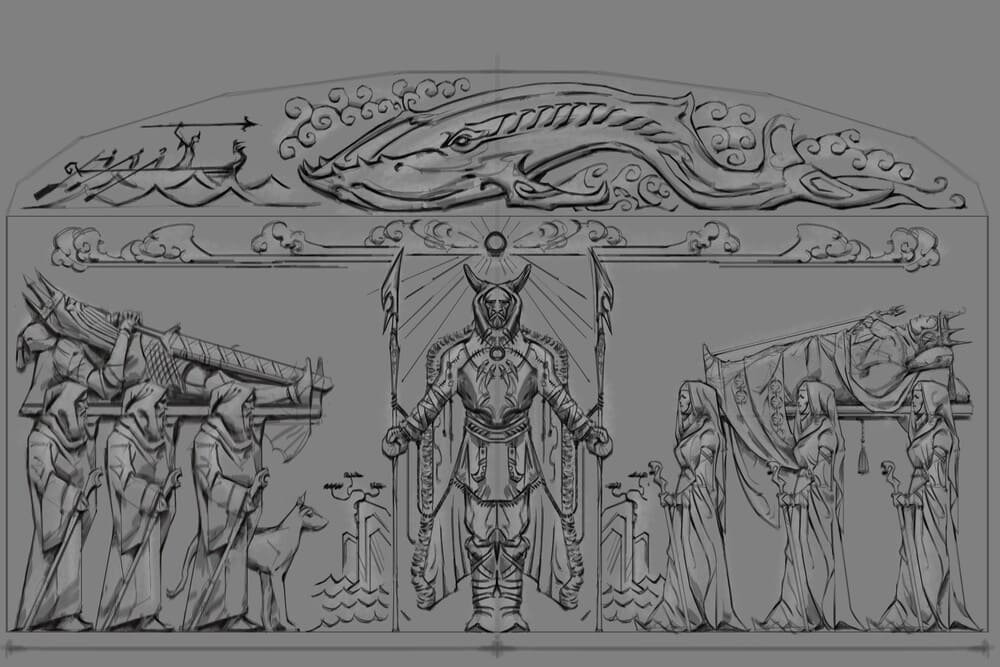 Skyrim Skyrim
|
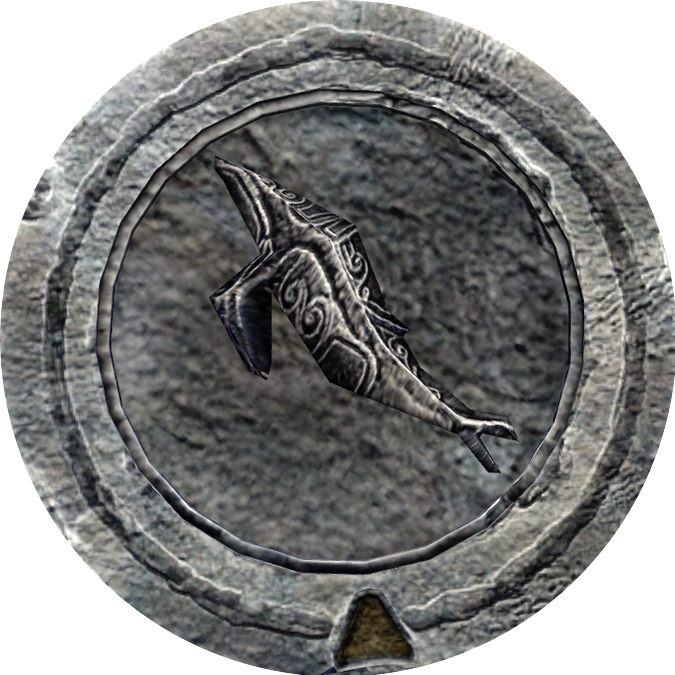 ESO ESO
|
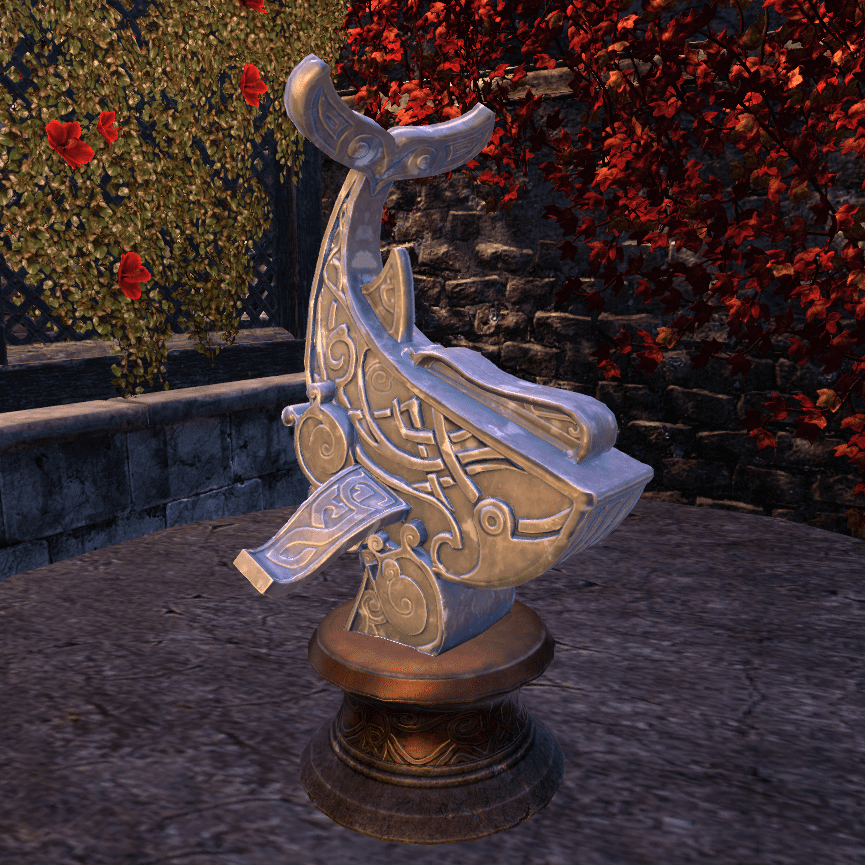 ESO ESO
|
|---|---|---|
|
Stuhn was represented by the whale under the animalistic religion of Atmora. During the Merethic Era the ancient Nords created various totemic depictions of the whale (or figures bearing whale-like imagery) in honor of the God of Ransom, many of which could be found in temples and tombs across Skyrim.[16][17] The worship of Stuhn eventually fell out of favor among Nords, and he became known as Stendarr when the Nordic faith shifted towards the Divines.[29] |
An opal Carved Whale Totem was uncovered in the mid-Second Era by the Antiquarian Circle in Skyrim. This discovery was of particular note, given it appeared less devotional than other Stuhn-precursor carvings. Some historians speculated that this sculpture was instead possibly a depiction of the fabled flying whales that live among the clouds in Skyrim.[57] | |
Syrabane[edit] | |
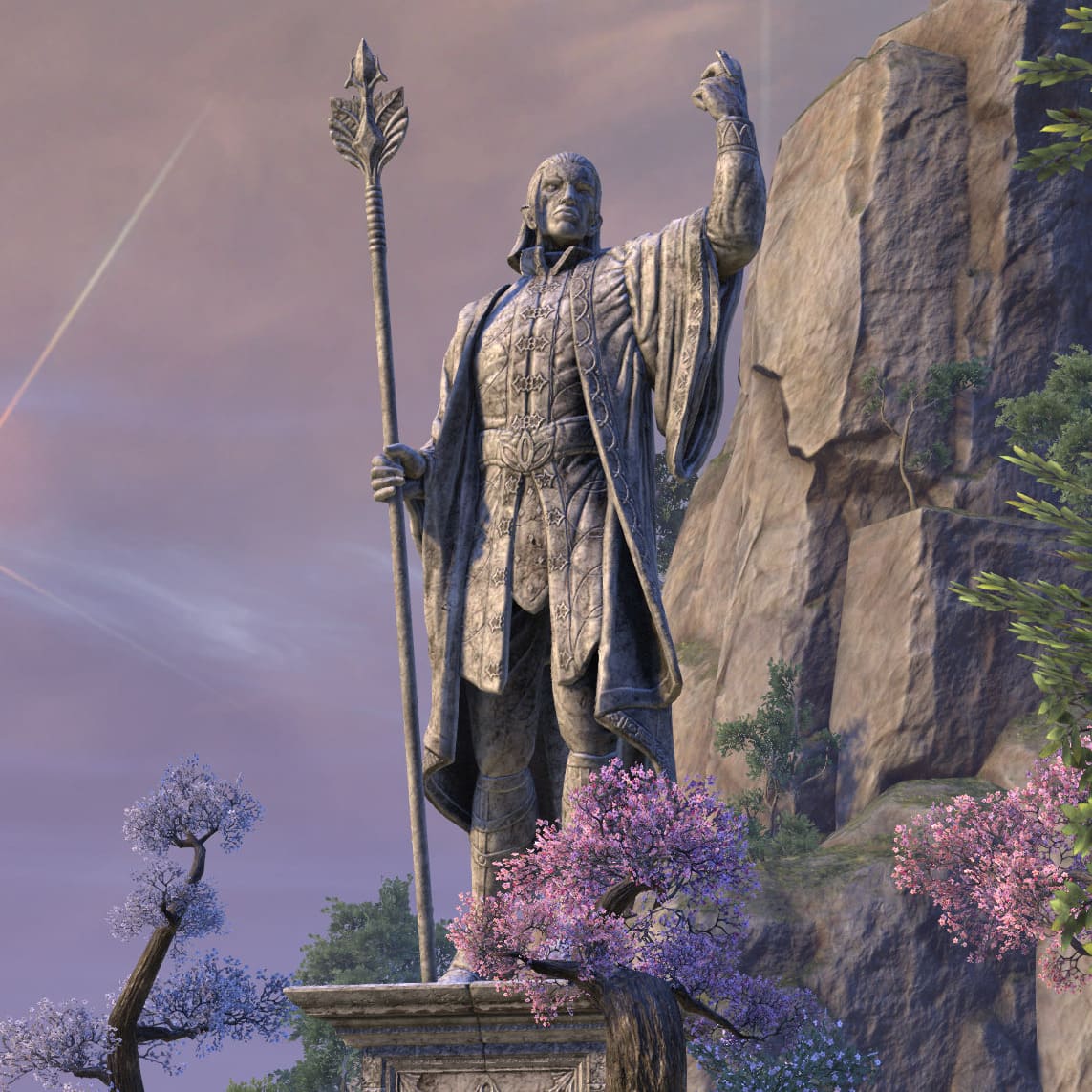 ESO ESO
|
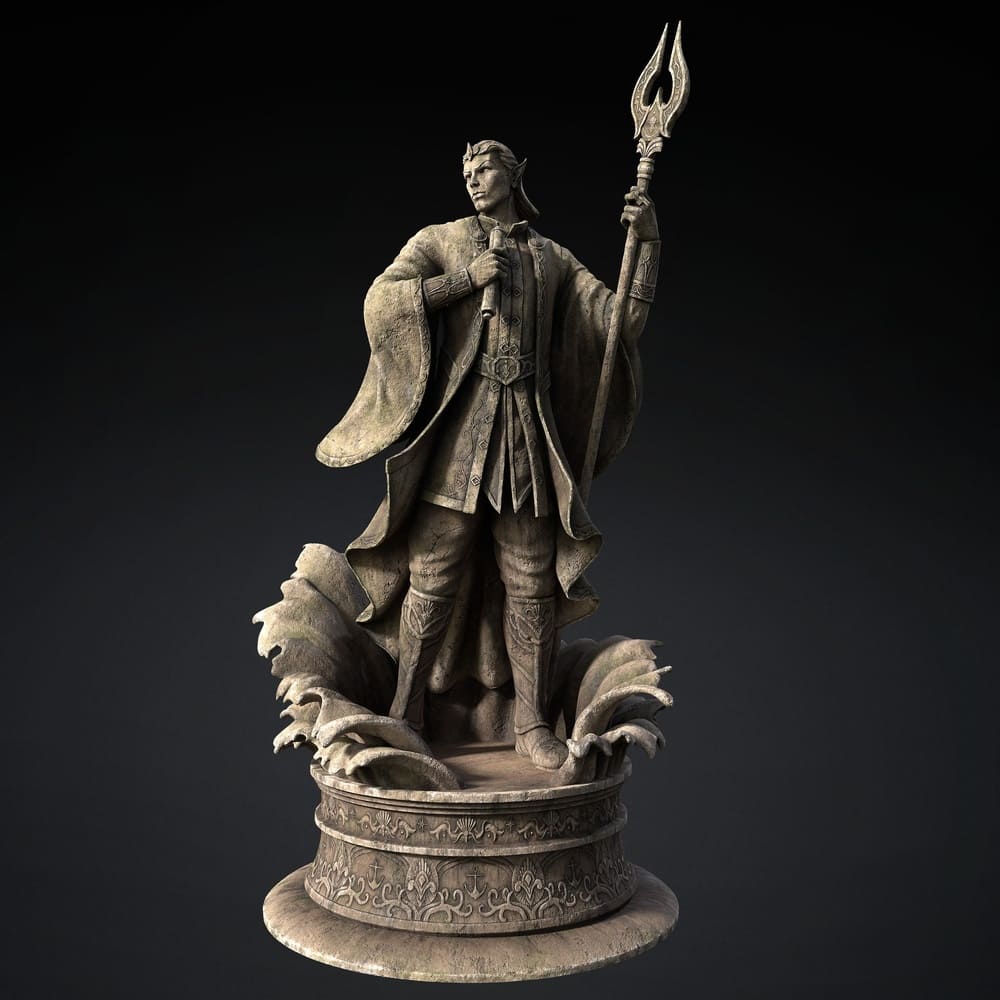 ESO ESO
|
|---|---|
|
Syrabane became revered as a god as Altmeri society developed.[58] As such, a grand statue of him stands on the coastal cliffs of Artaeum, which he supposedly posed for in-person.[59] |
It is unclear whether Bretons of the Systres Archpelago venerate Syrabane as a deity or as a prominent historical figure, given he aided Bendu Olo in his war against the Sload,[29] but statues and numerous figurines of the Warlock's God were found on the archipelago during the mid-Second Era.[60][61] This included a crystal likeness of the Warlock's God, carried by Syrabane's faithful that was said to ward off curses and disease.[62] |
Tava[edit] | |
|
An enormous rock carving of a bird's head, known as Tava's Beak, was found on the southern coast of Hew's Bane during the mid-Second Era. According to Redguard theology, Tava is known as the bird god,[29] and the goshawk and redtail hawk are considered to be sacred to her.[63][64] |
 ESO ESO
|
Tiber Septim / Talos[edit] | |||
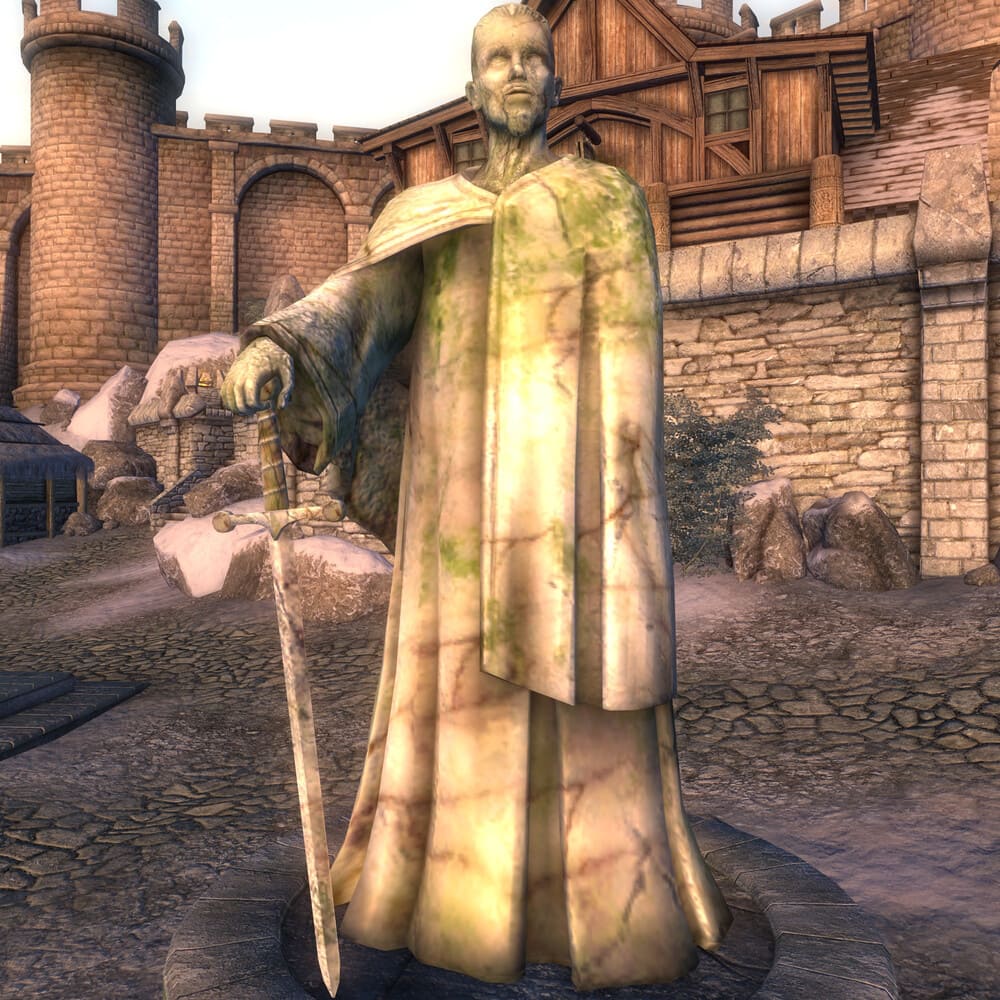 Oblivion Oblivion
|
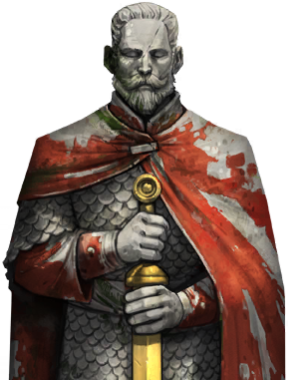 Blades Blades
|
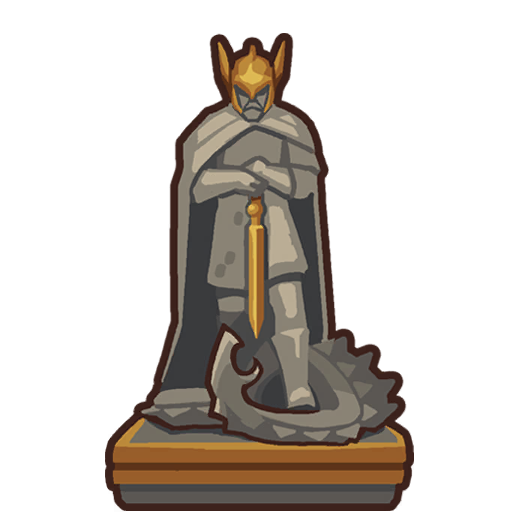 Castles Castles
|
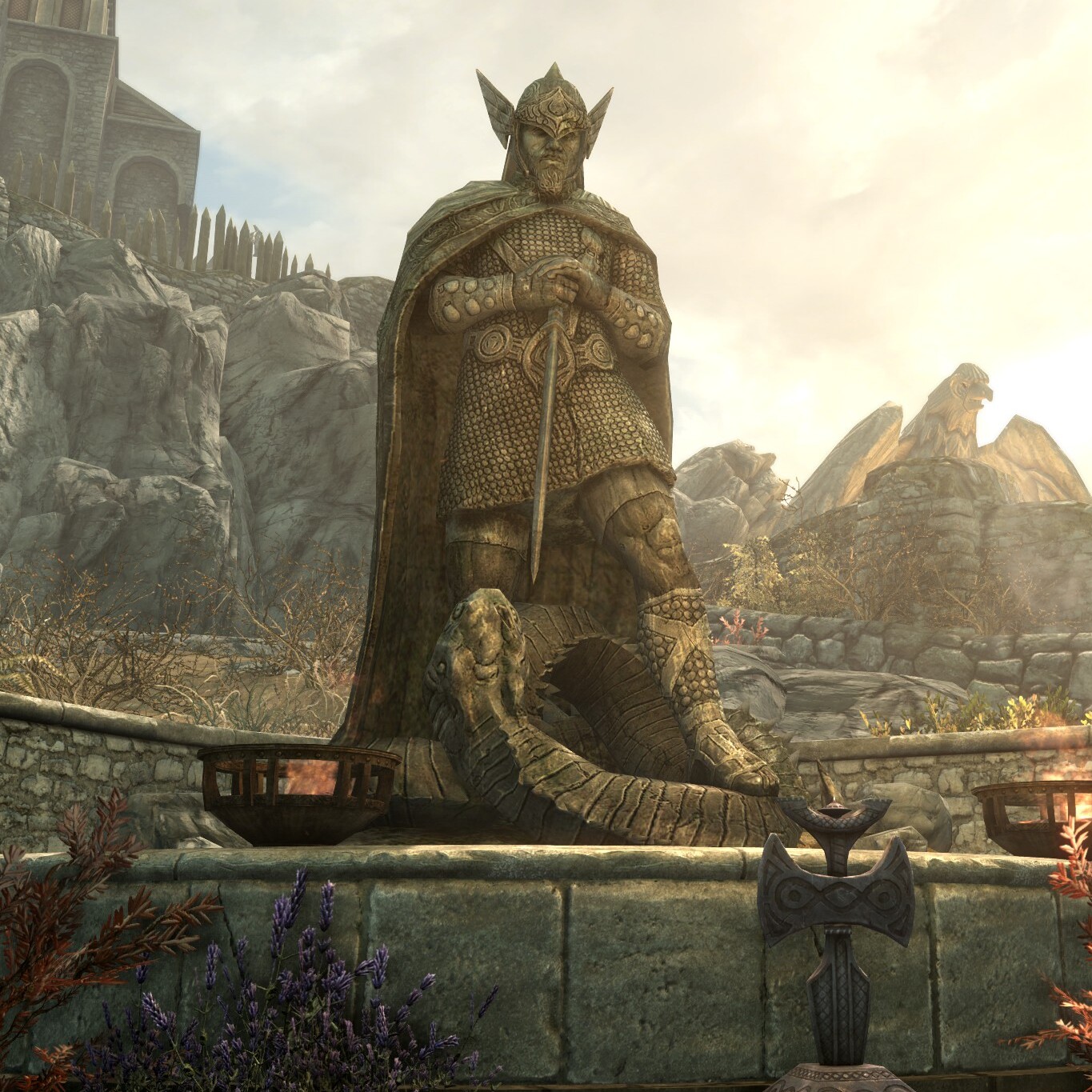 Skyrim Skyrim
|
|---|---|---|---|
|
During the late-Third Era and Fourth Era, statues of Tiber Septim could be found in parts of Cyrodiil, such as the city of Bruma or temples of Talos, where he is depicted wearing a cape and holding a sword.[65]:357[66] Some took issue with the central placement of the statue of Talos in Arboretum District of the Imperial City. Claiming that he was only given favorable placement in comparison to the king of gods, Akatosh, due to the Elder Council seeking favor with the sons of Talos.[67] In the aftermath of Great War, the controversial White-Gold Concordat was signed which saw the complete ban of all worship of Talos.[68] As such, his statues, shrines and temples were removed, although some parts of Skyrim that opposed the ban openly defied this.[69][70] |
Around the same time in Skyrim, Talos was historically revered as a Nord who possessed unmatched tactical skill, limitless wisdom, and the power to see into men's hearts.[71] As such, statues and shrines of Talos were relatively common throughout the land, despite the White-Gold Concordat, and could be seen in major cities such as Whiterun, Windhelm and Markarth. These versions depict Talos in full chainmail armor and a winged helm as he is about to impale a serpent through the mouth with his sword. Although the symbology of this is unclear, it bears striking similarities to shrines of Akatosh, where the Dragon-God appears to be swallowing a sword. | ||
Trinimac[edit] | ||
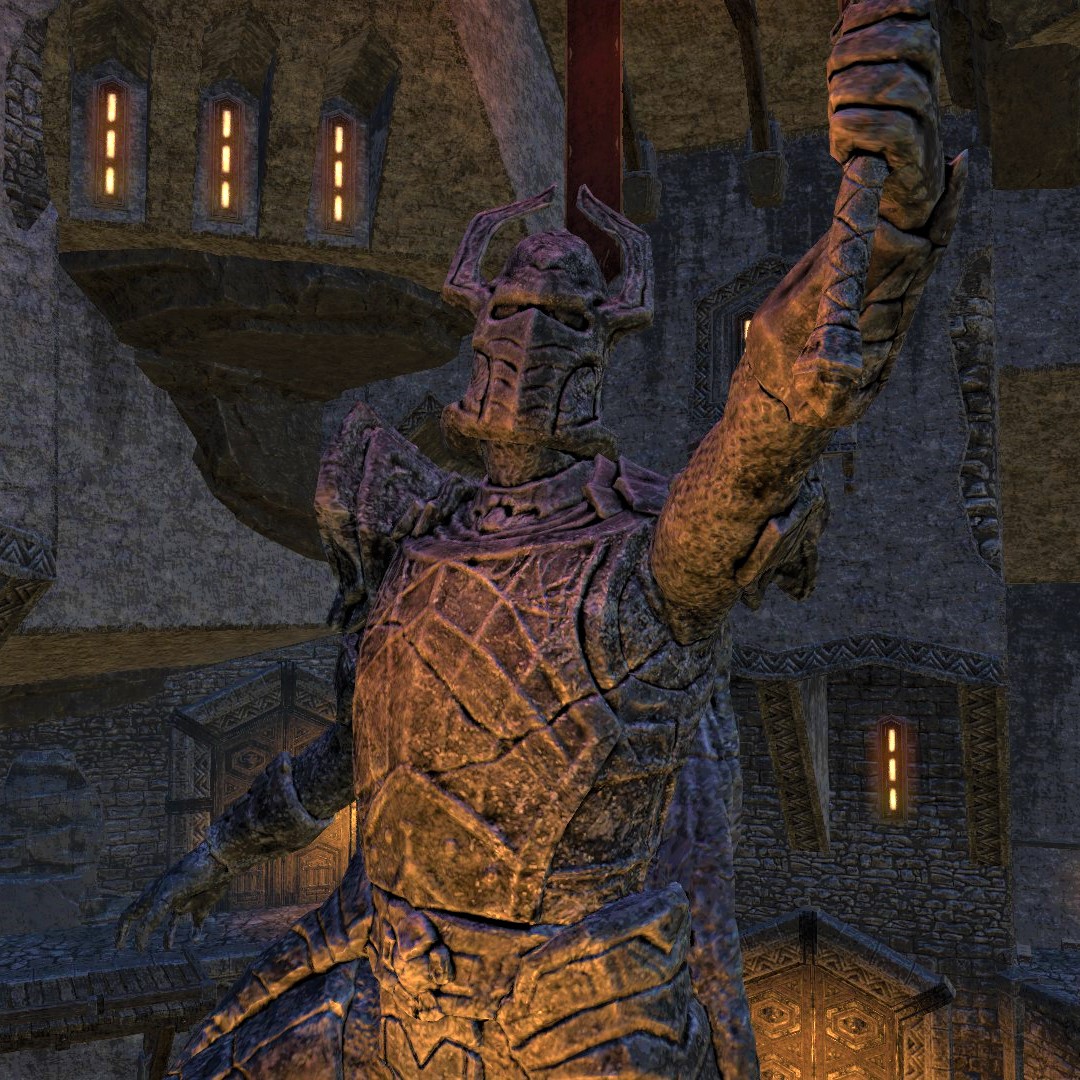 ESO ESO
|
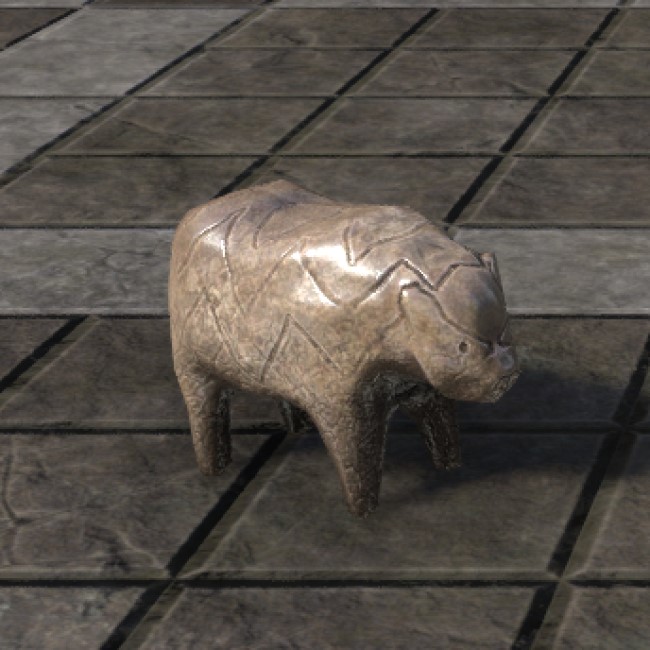 ESO ESO
|
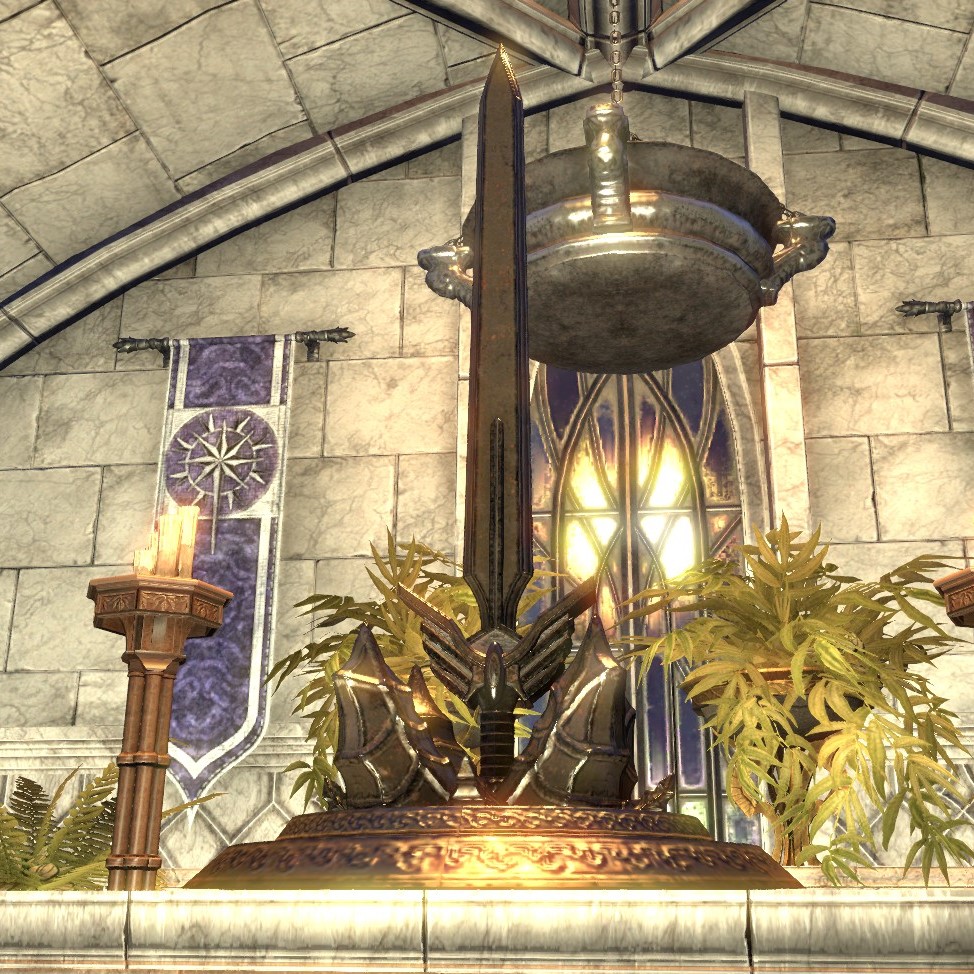 ESO ESO
|
|---|---|---|
|
A statue of Trinimac was erected in the rebuilt Temple of Ire in Orsinium after King Kurog reinstated the worship of the deity during the Second Era.[72] The statue depicts Trinimac in full armor and holding aloft his legendary blade, the Penitent. During this time the Vosh Rakh cult attempted to forcibly convert the Wrothgarian Orcs towards the worship of Trinimac and abandon Malacath.[73] Despite this, there was fierce debate in Orsinium as to which deity the temple should be dedicated to.[74] Other examples of Orcish depictions of Trinimac include gilded statuettes that serve as paperweights.[75] |
During the early-First Era when the worship of Malacath was ubiquitous in Orsinium, some Orcs were intent on worshiping Trinimac, even if meant in the privacy of their own homes. These Orcs fashioned small, gold-cast idols of stylized animals, including bears, pigs, goats, and even horkers. Despite not being direct depictions of Trinimac, these idols bore his mark and were placed inside homes to provide protection, comfort, and a focal point for private worship. The area around Paragon's Remembrance in Wrothgar, an ancient site devoted to the veneration of Trinimac, has long been a source of these tiny statues.[76] |
An Altmeri shrine to Trinimac, warrior-god of the Elves, was found in the Monastery of Serene Harmony on Summerset Isle. Trinimac's shrine depicts his holy sword, the Penitent.[77] According to Altmeri legend, he led Elven armies against the Men before he vanished from the mythic stage.[29] Other Altmeri depictions of Trinimac are made of bronze or rose quartz, and include statuettes and figurines of the deity kneeling with his sword raised defiantly into the air.[78][79] |
Tsun[edit] | |
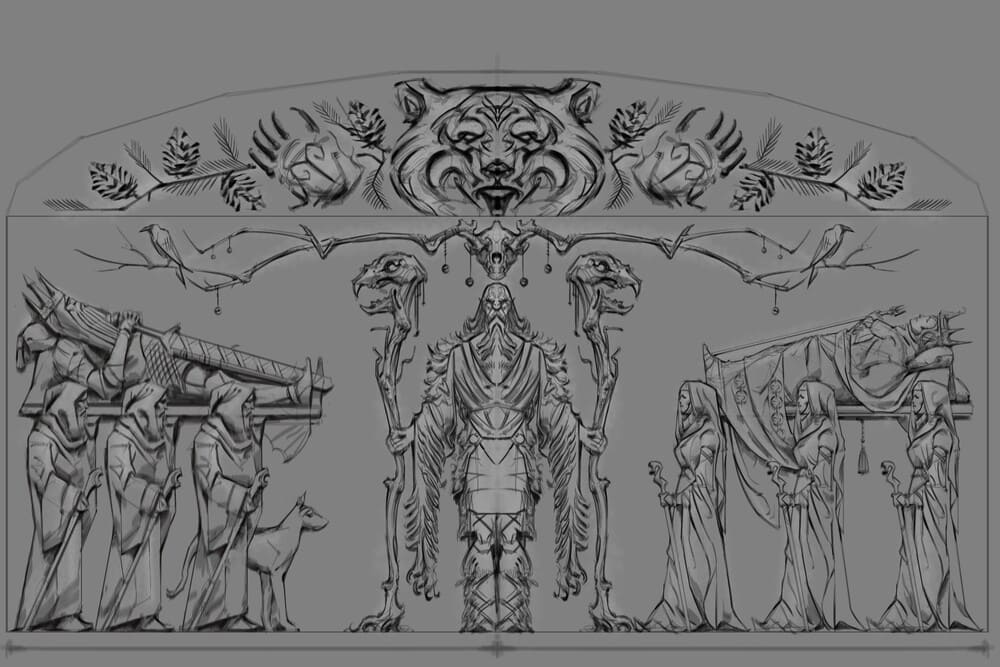 Skyrim Skyrim
|
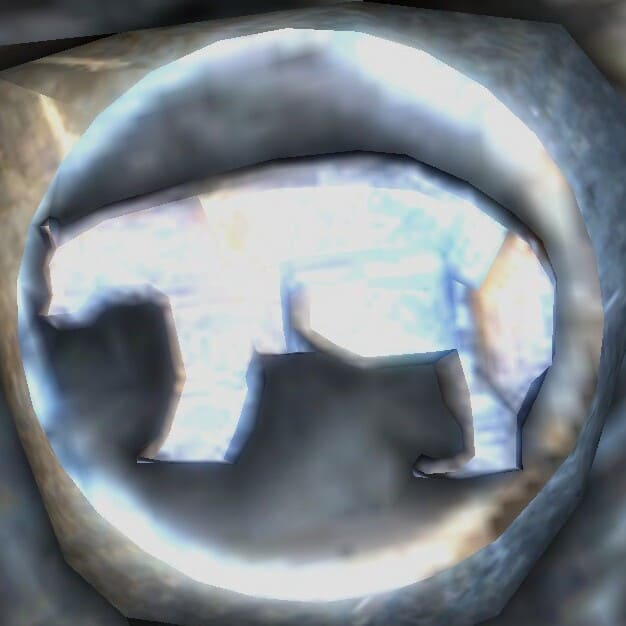 Skyrim Skyrim
|
|---|---|
|
Tsun was represented by the bear under the animalistic religion of Atmora.[80] During the Merethic Era the ancient Nords created various totemic depictions of the bear (or figures bearing bear-like imagery) in veneration of the deity, which could be found in temples and tombs across Skyrim.[16] Considered to be a "dead god" who fought and died defending Shor, the worship of Tsun was never as prevalent as the other Aedra in the Nordic pantheon.[16][17][29] As such, almost no direct iconography of Tsun exists, although some sects, such as the Ternion Monks, still revere the bear.[51] | |
Tu'whacca[edit] | |
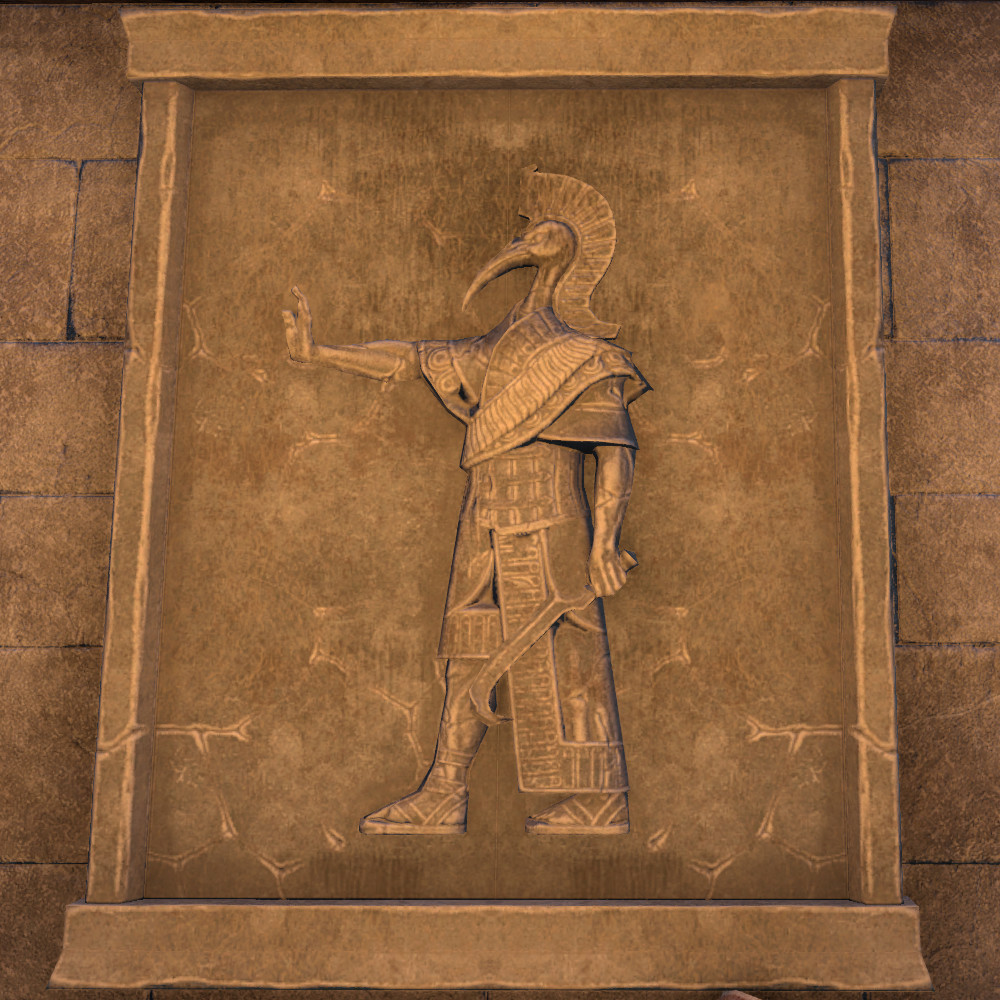 ESO ESO
|
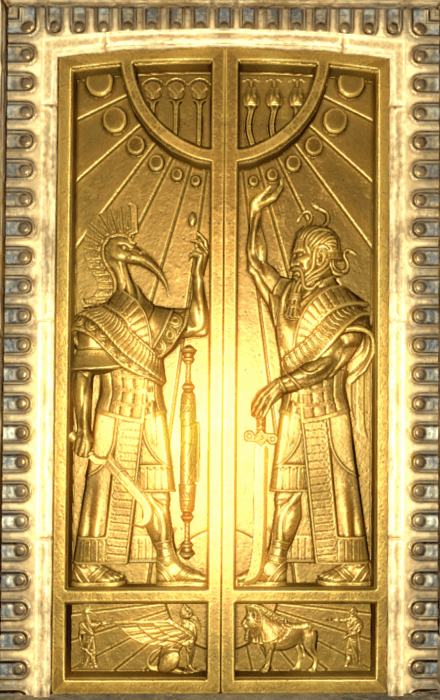 ESO ESO
|
|---|---|
|
In Yokudan theology, the ibis is considered sacred and oft associated with Tu'whacca, the God of Souls. His purpose is the caretaker of the Far Shores, and Redguards believe he helps their souls find their way into the afterlife.[81] His veneration is best illustrated in tombs and burial places, where Tu'whacca is represented in statuary and reliefs as a figure with the head of an ibis and the body of a man. These resting places are also sometimes replete with numerous funerary statues that depict a winged ibis-lion creature, such as the Al-Danobia tomb in Hammerfell. In other reliefs, Tu'whacca can be seen facing a Serpent god, likely Sep or Satakal, both with their hands raised.[82] | |
Xarxes[edit] | |
|
Xarxes is depicted in a large statue found in the Monastery of Serene Harmony in Shimmerene. The god of ancestry and secret knowledge served as scribe to Auri-El and has kept track of all Aldmeri accomplishments, thus he stands back-to-back with Auri-El's statue while holding a book emblazoned with a sun-shaped sigil.[55] |
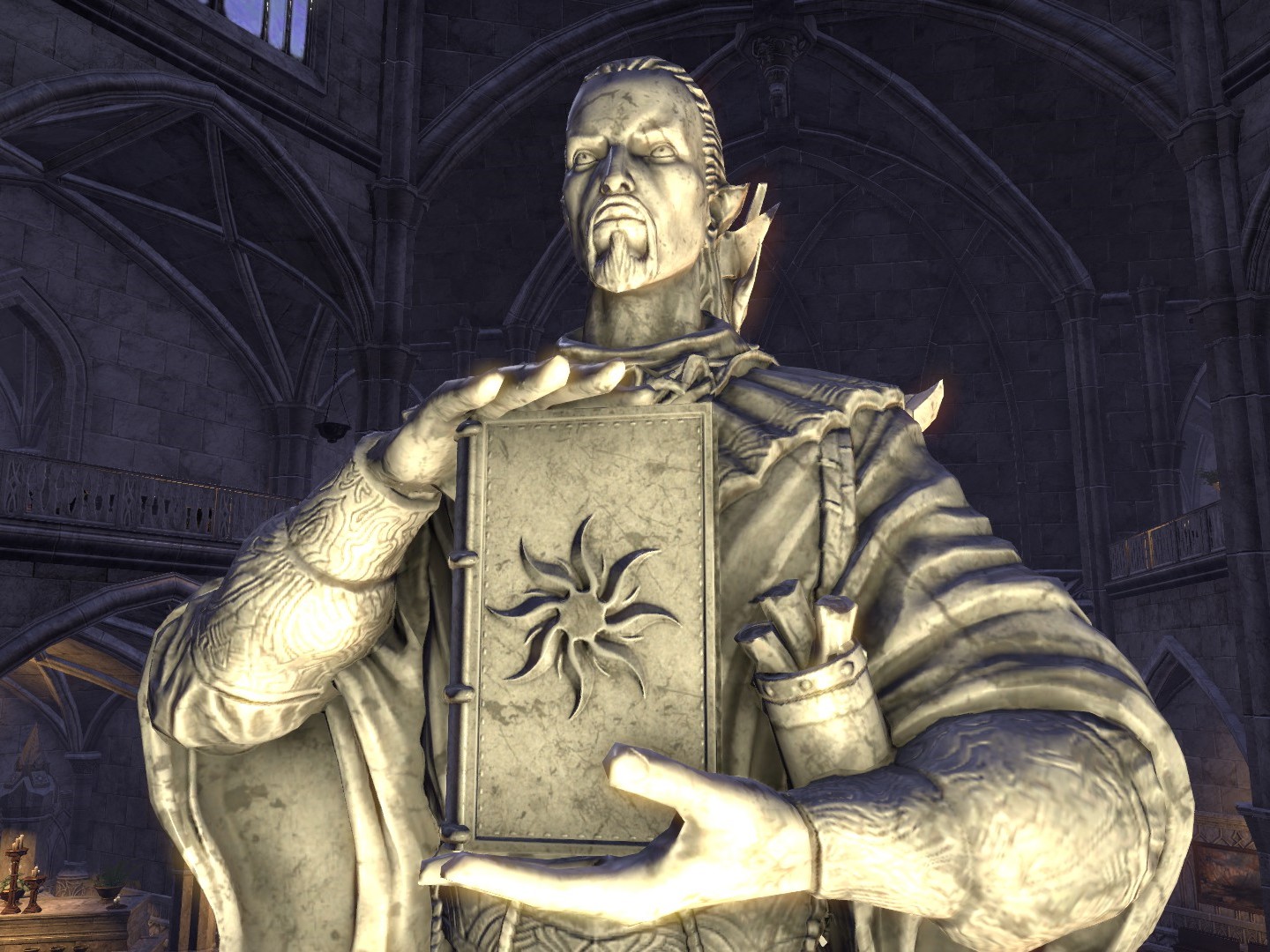 ESO ESO
|
Z'en[edit] | |
|
A idol of Z'en, the God of Agriculture, was uncovered in the mid-Second Era by the Antiquarian Circle in Blackwood. Although Z'en is more commonly associated with the Bosmer as a vengeful god, this discovery was of particular note because it was believed to be Kothringi in origin, given its curvilinear design elements and its focal shape depicting a spade. Indeed, some scholars speculate the Bosmer were introduced to the deity by Kothringi sailors before the race's extinction. Scholars suggest further that the Kothringi viewed Z'en sphere to include equitable trade, basic fairness, and so on - to the extent that their reverence for him played a role in shaping their values of decency and forthrightness.[83][29] |
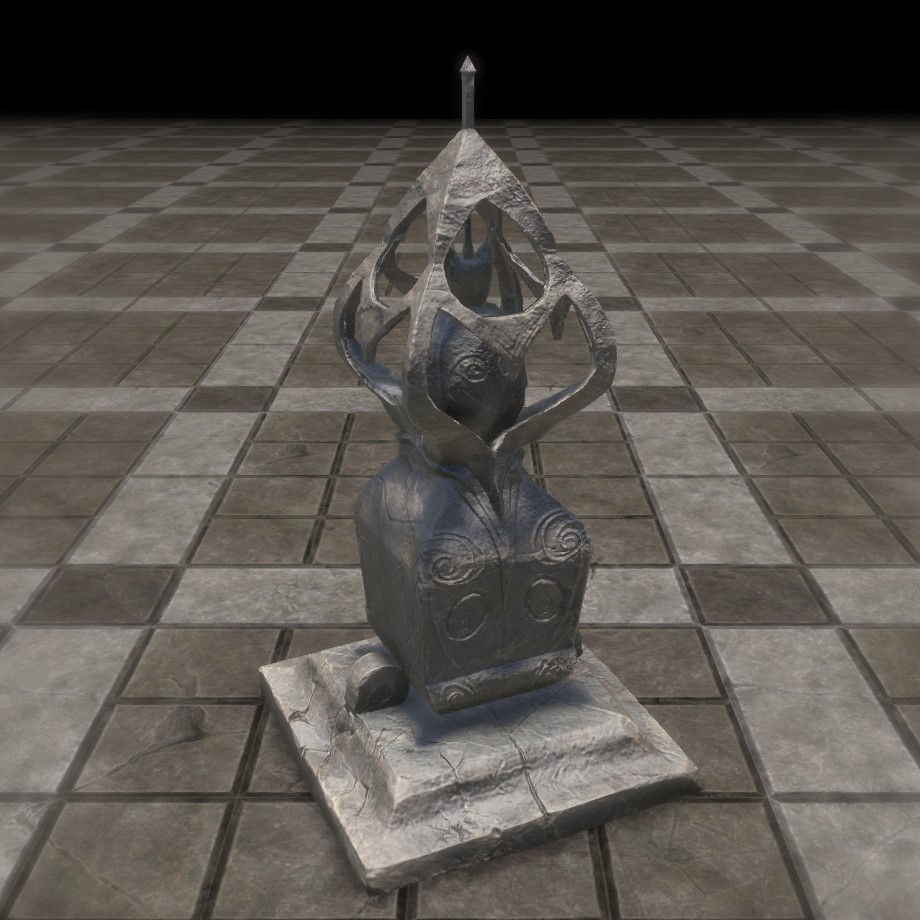 ESO ESO
|
Zenithar[edit] | ||||
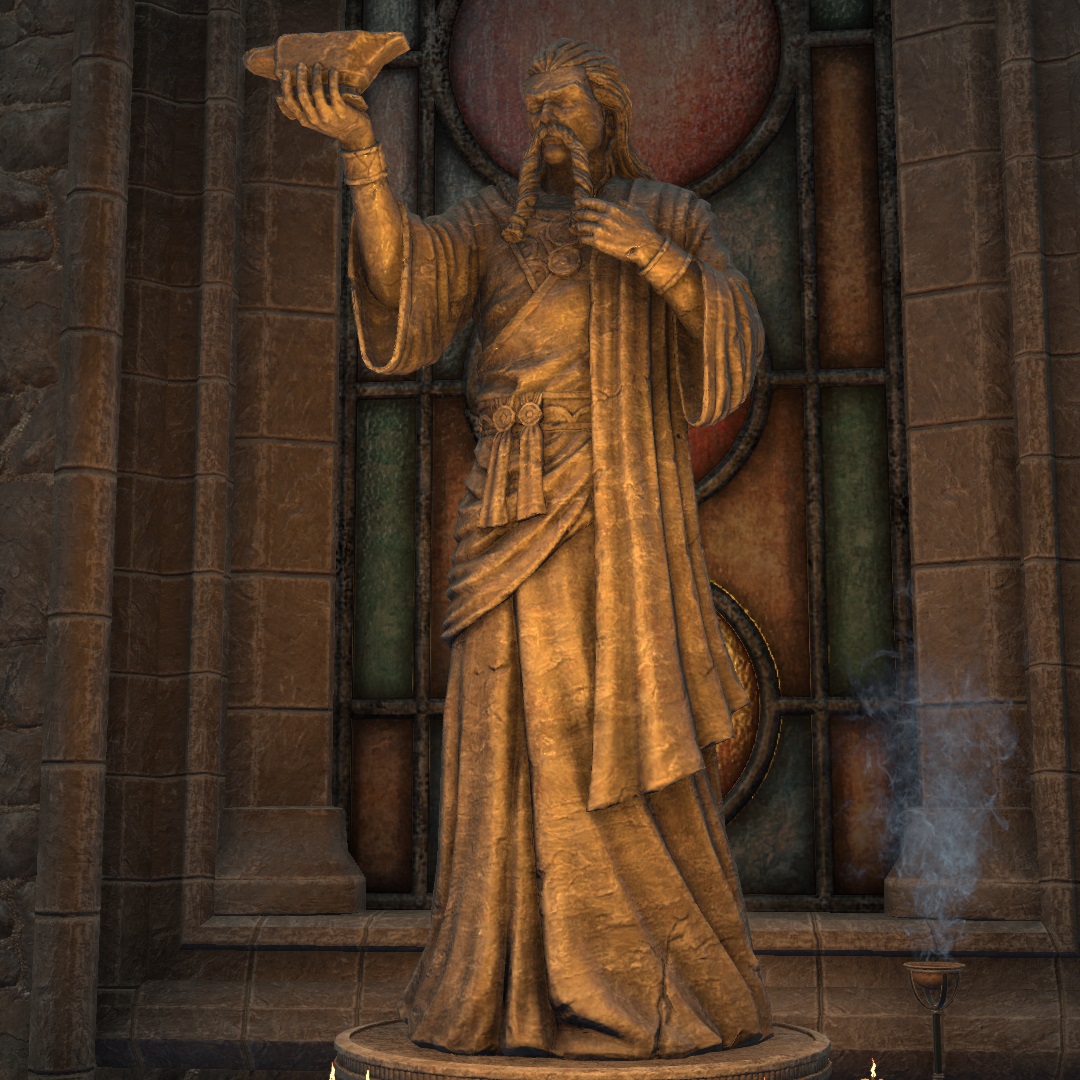 ESO ESO
|
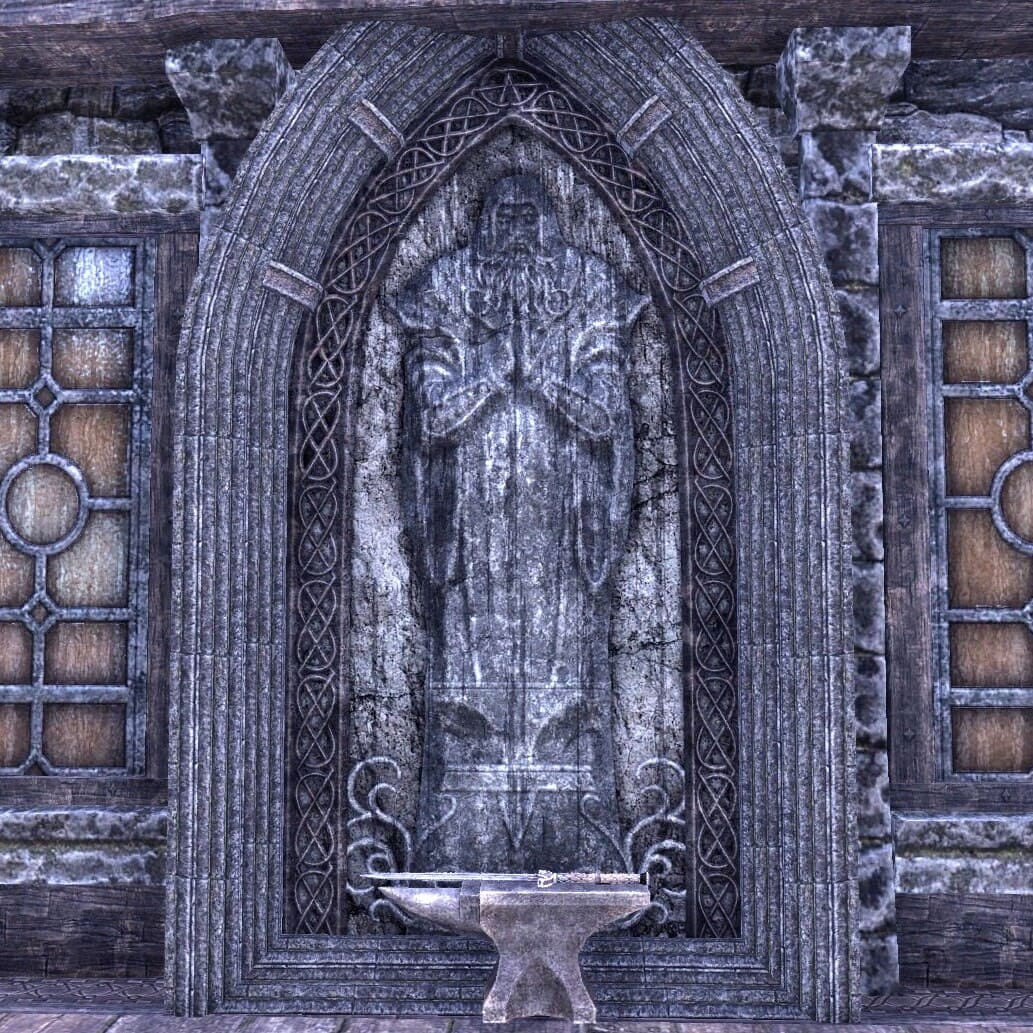 ESO ESO
|
 Daggerfall Daggerfall
|
 Oblivion Oblivion
|
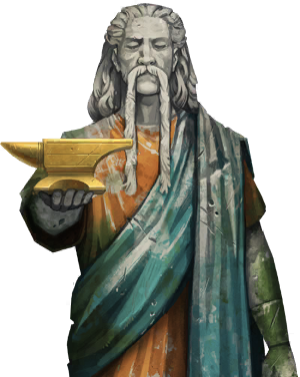 Blades Blades
|
|---|---|---|---|---|
|
Statuary of Zenithar has remained relatively consistent throughout the eras after his worship became established under the religion of the Divines. Zenithar is typically depicted as a robed, old man holding an anvil to symbolize his sphere of labor, wealth and commerce. Shrines of Stendarr are somewhat simplified and depict only the anvil itself.[84] Worshippers of Zenithar often keep small devotional anvils in their homes.[85] Statues of Zenithar could be found in various Imperial and Breton settlements during the Second and Third Era, notably in the Arboretum District of the Imperial City and the Great Chapel of Zenithar in Leyawiin.[8][55] The Trader God is also associated with the Bosmeri god Z'en, however Zenithar is considered a more cultivated god of merchants and middle nobility.[29] | ||||
Notes[edit]
- ^ In TES:V: Skyrim, the hawk bas-relief that represents Kyne is typically found in Nordic ruins, however in once instance its found in Rebel's Cairn, the tomb of Red Eagle. The association of this bas-relief with Red Eagle is somewhat of a paradox, given Red Eagle was a Reachman from the First Era who didn't have any known association with the ancient Nordic deity. The likely explanation is that this bas-relief was re-used by the game's designers to decorate Red Eagle's tomb with eagle-like imagery, given the similarities between the hawk and the eagle.
- ^ In TES:V: Skyrim, the wolf bas-relief that represents Mara is typically found in Nordic ruins, however in once instance its found in Potema's Catacombs beneath Solitude. Connecting this bas-relief with Potema the Wolf-Queen is somewhat of a paradox, given she was from the Third Era and didn't have any known association with the ancient Nordic deity. The likely explanation is that this bas-relief was re-used by the game's designers to decorate the Wolf-Queen's catacombs with existing wolf-like imagery.
- ^ Stendarr's chalice/horn bears striking similarities to the Horn of Plenty - a large horn-shaped container overflowing with produce, flowers, or nuts. In Greek and Roman mythology it was a symbol of abundance and nourishment and was attributed to several deities associated with the harvest and prosperity.
References[edit]
- ^ Moon-Bishop Azin-jo's dialogue in ESO: Elsweyr
- ^ Golden Dragon Statue treasure item in ESO
- ^ The Black Dragon's Journal, Part 2 — The Black Dragon
- ^ Carved Dragon Figurine treasure item in ESO
- ^ Ice Dragon Bust description in Blades
- ^ Appearance of statue in Morrowind
- ^ The Elder Scrolls IV: Oblivion Official Game Guide — Peter Olafson — "Statue of Akatosh: The Dragon God of Time in his Dragon aspect."
- ^ a b c d Appearance of statue in Oblivion
- ^ Light the Dragonfires quest in Oblivion
- ^ Shrine of Akatosh in Skyrim
- ^ Arkay Votive Figure treasure item in ESO
- ^ Elderscrollsonline.com: Knowledge Base Q & A
- ^ Driftwood Idol treasure item in ESO
- ^ Winged Auri-El treasure item in ESO
- ^ Welcome to New Aldmeri Irregulars — Aicantar of Shimmerene, Sapiarch of Indoctrination
- ^ a b c d e f g h i Divines and the Nords — High Priest Ingurt
- ^ a b c d e f g h The Song of Gods
- ^ a b Shezarr and the Divines — Faustillus Junius
- ^ Five Songs of King Wulfharth
- ^ Dibella Ritual Stone in ESO
- ^ Dibella emblem in ESO
- ^ Alabaster Dibella Statuette treasure item in ESO
- ^ Ceramic Dibella Figurine treasure item in ESO
- ^ Dibella's Bosom Night Favor treasure item in ESO
- ^ Ruby-Studded Dibella Statue treasure item in ESO
- ^ Dibellan Worry Idol treasure item ESO
- ^ Of Jephre — Anonymous
- ^ Holy Symbol of Jhunal treasure item description in ESO
- ^ a b c d e f g h i j k l m n Varieties of Faith... — Brother Mikhael Karkuxor of the Imperial College
- ^ NPC dialogue about the School of Julianos in Daggerfall
- ^ Crafting Motif 4: Nord Style — Doctor Alfidia Lupus
- ^ White-Ash Kyne treasure item in ESO
- ^ Kynareth's statue in Leyawiin in ESO
- ^ Statue, Kynareth's Blessings furnishing in ESO
- ^ Scrimshaw Kynareth treasure item in ESO
- ^ NPC dialogue in Morrowind
- ^ Magnus Cult Wicker Effigy treasure item in ESO
- ^ Wolf Mara Figure treasure item in ESO
- ^ Taxidermied Wolf and Suckling Cubs
- ^ Maramal's dialogue in Skyrim
- ^ Jurisreeve Lorne's dialogue in ESO
- ^ Ritual of Mara in ESO
- ^ Mara Fertility Fetish treasure item in ESO
- ^ Varieties of Faith, The Forebears — Brother Mikhael Karkuxor of the Imperial College
- ^ Morwha's Blessing antiquity codex entries in ESO
- ^ Nord House God treasure item in ESO
- ^ a b c Varieties of Faith: The Nords — Brother Mikhael Karkuxor of the Imperial College
- ^ Tu'whacca, Arkay, Xarxes — Lady Cinnabar of Taneth
- ^ Notice: Hall of the Dead — Hjurring
- ^ Coil of Satakal antiquity codex entry in ESO
- ^ a b The Ternion Monks — Elgad the Scribe
- ^ Fragmentae Abyssum Hermaeus Morus
- ^ Ebony Fox Totem antiquity codex entries in ESO
- ^ Shrine of Stendarr in Skyrim
- ^ a b c Appearance of statue in ESO
- ^ NPC dialogue about the Temple of Stendarr in Daggerfall
- ^ Carved Whale Totem antiquity codex entries in ESO
- ^ Pocket Guide to the Empire, 3rd Edition: The Blessed Isle: Alinor and the Summersets — Imperial Geographical Society, 3E 432
- ^ 2920, Sun's Dawn — Carlovac Townway
- ^ Gonfalon Bay in ESO: High Isle
- ^ Syrabane Statuette treasure in ESO: High Isle
- ^ Syrabane's Safeguardian treasure item in ESO
- ^ Royal Redtail Hawk Writing Quill item description in ESO
- ^ The Worthy Ar-Azal, His Deeds
- ^ The Elder Scrolls IV: Oblivion Official Game Guide — Peter Olafson — "Statue of Tiber Septim: God of War and Governance, Emperor and Founder of the Septim dynasty."
- ^ Like Father, Like Son quest in Blades
- ^ Guide to the Imperial City — Alessia Ottus
- ^ The Great War — Legate Justianus Quintius
- ^ Freir's dialogue regarding the Temple of the Divines in Skyrim
- ^ Temple of Talos in Skyrim
- ^ Heimskr's dialogue in Skyrim
- ^ High Priestess Solgra's dialogue in ESO
- ^ Events of Blood on a King's Hands in ESO
- ^ Temple of Ire loading screen in ESO
- ^ Gilded Trinimac Parchment Weight treasure item in ESO
- ^ Trinimac House Idol
- ^ Trinimac Priest's dialogue in ESO
- ^ Statuette of Trinimac treasure item in ESO
- ^ Humbled Hero Figurine treasure item in ESO
- ^ Frostbane Bear description in ESO
- ^ Varieties of Faith, The Forebears — Brother Mikhael Karkuxor of the Imperial College
- ^ Statues in Al-Danobia Tomb in ESO
- ^ Z'en Idol antiquity codex entry in ESO
- ^ Shrine of Zenithar in Skyrim
- ^ Zenithar Wood Sculpture item description in ESO